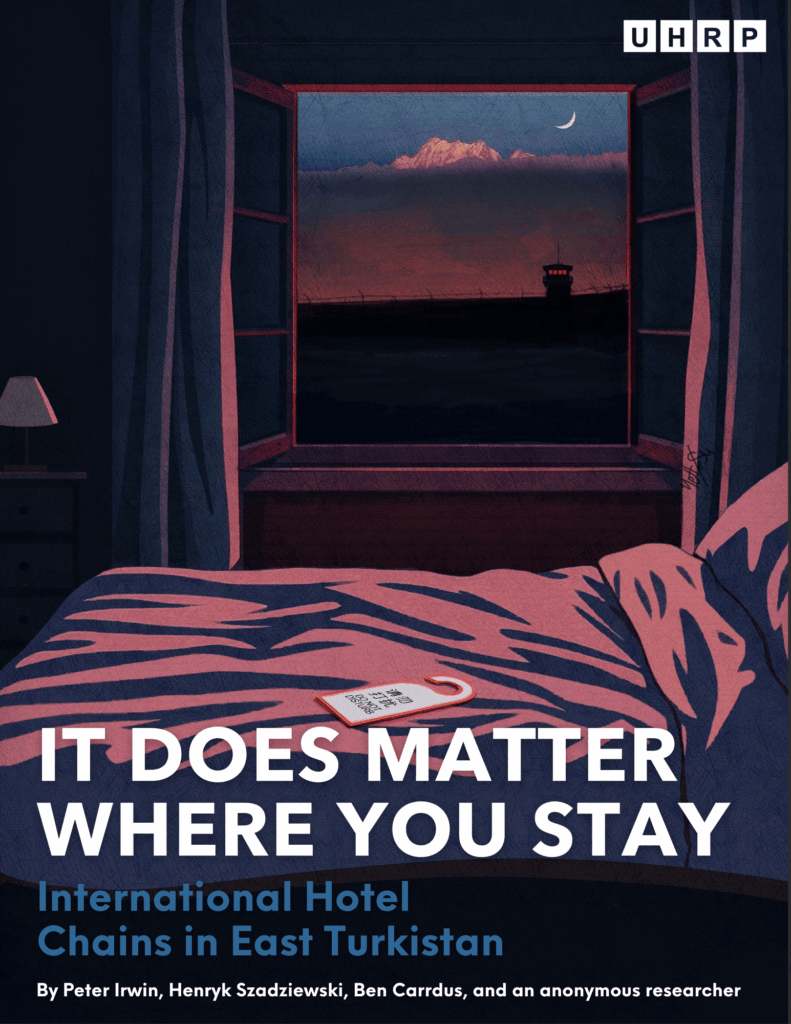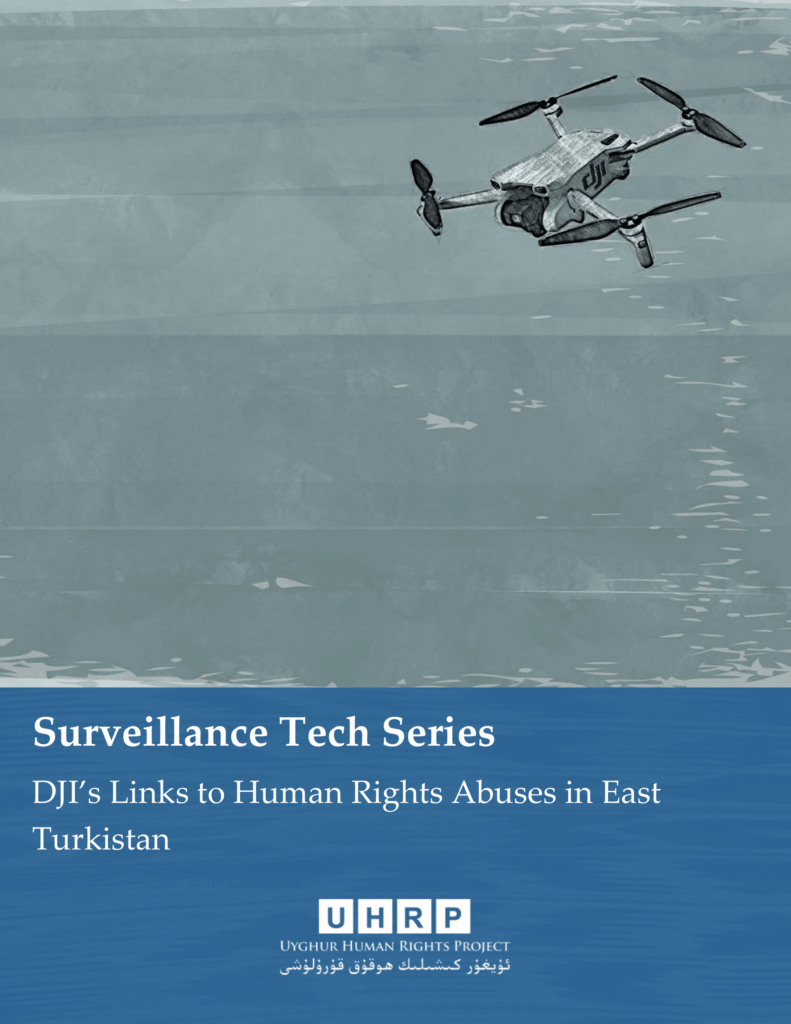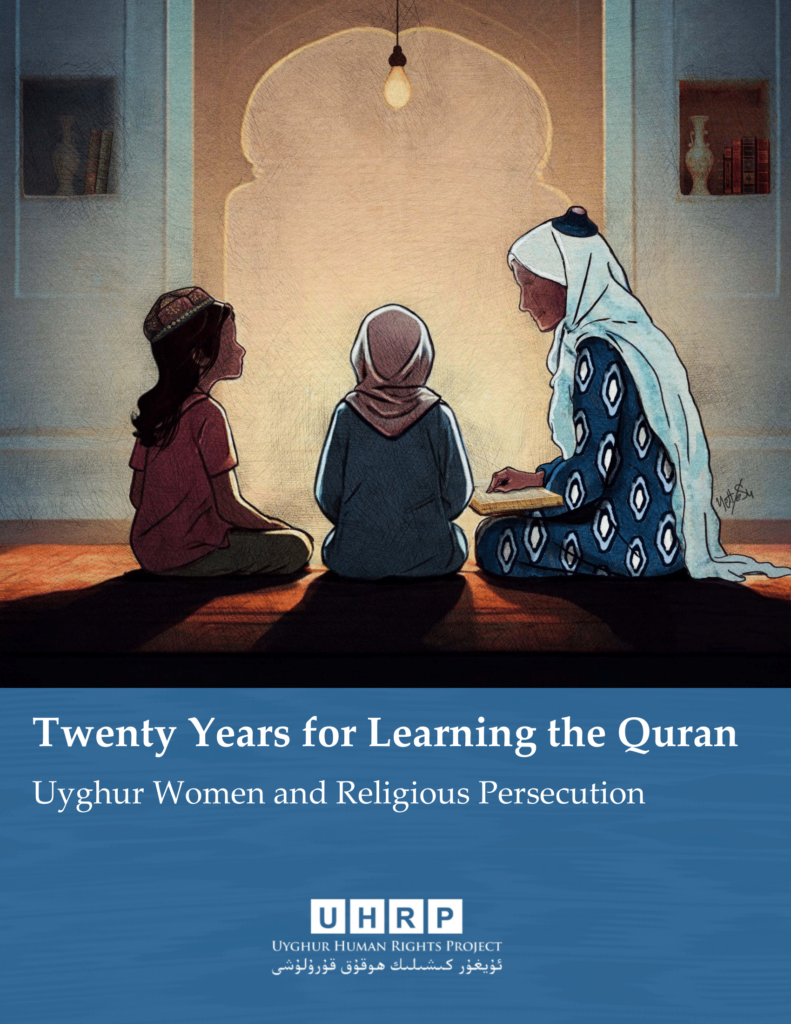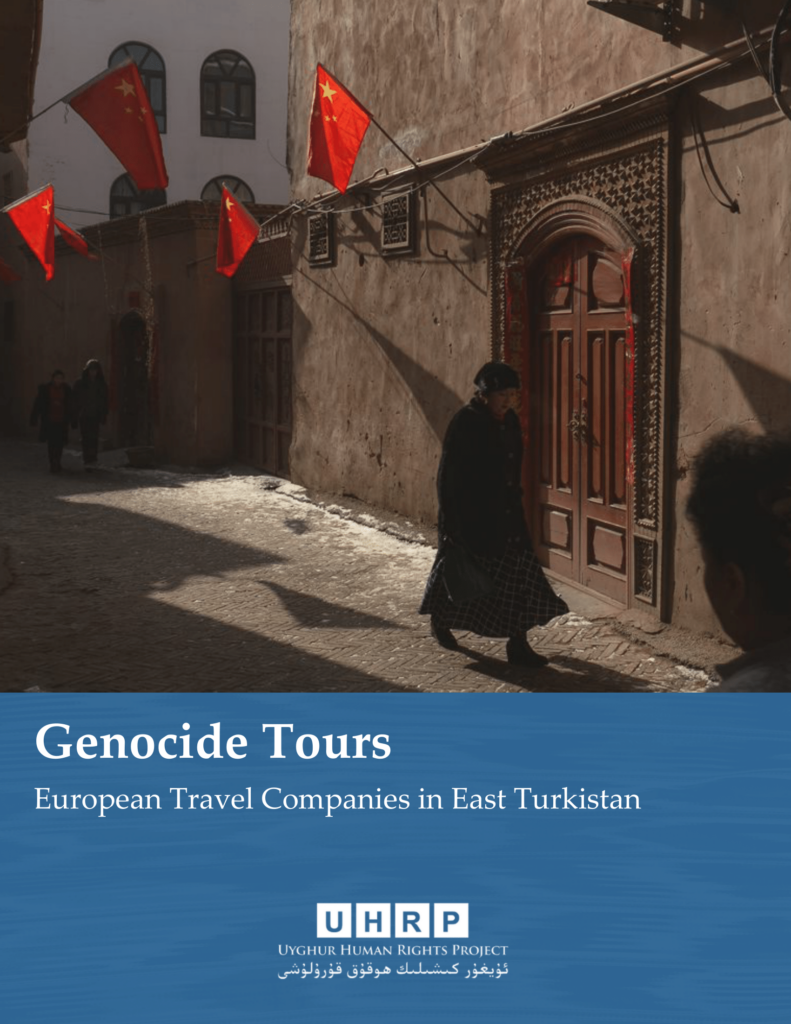A Uyghur Human Rights Project report by Bahram K. Sintash. Read our press statement on the report here, and download the full report here.

Key Takeaways
- The Chinese government has undertaken a campaign to eradicate tangible signs of Islamic identity across the Uyghur region, including by demolishing mosques;
- Since 2016, over 100 mosques have been fully destroyed or have had an architectural element removed, like domes, minarets, crescent moons, and Arabic script;
- Centuries-old mosques have been fully or partially destroyed in the campaign, including the complete demolition of the Kargilik Grand Mosque, built around 1540 CE, as well as the demolition of the historic gatehouse of the Keriya Id Kah Mosque, built around 1200 CE;
- The destruction of smaller village or neighborhood mosques, along with the detention and imprisonment of imams, leaves larger mosques easier to monitor and control by the Chinese government;
- A case study of 11 mosques and religious sites, including photographs, satellite imagery, and testimony from local residents, offers comprehensive evidence of a Chinese government campaign meant to destroy religious sites and marginalize Uyghurs and other Turkic peoples;
- The campaign to demolish and alter mosques has been implemented alongside broader Chinese government policies aimed at eliminating or marginalizing Uyghur religious practice and expression.

I. Summary
The Chinese government’s current crackdown in the Uyghur region is aimed at eliminating Uyghur ethnocultural identity and assimilating them into an undifferentiated “Chinese” identity. As one of the cornerstones of their identity, Uyghurs’ Islamic faith has been a major target of this campaign, resulting in many Uyghurs being sent to the network of concentration camps.
This campaign has also taken the form of eradicating tangible signs of the region’s Islamic identity from the physical landscape. This has involved the whole or partial demolition of an unprecedented number of mosques, including several historically significant buildings. The destruction of mosques in the Uyghur homeland is nothing new; during the Cultural Revolution many were targeted in campaigns against the “Four Olds,” while more recently redevelopment campaigns such as that in Kashgar in 2009 have leveled mosques and the neighborhoods around them.
The lead researcher and primary author of this report is Bahram Sintash, who for the past year has been documenting this systematic destruction, providing valuable information for the media and human rights activists. By speaking to individuals who have recently left the region and analyzing satellite imagery, Mr. Sintash has compiled a list of mosques which have been confirmed or are suspected to have been demolished in the recent campaign.1Sintash, Bahram, “List of Demolished Uyghur Mosques in XUAR” https://www.uyghurism.com/culturalgenocide Mr. Sintash has discovered evidence that over 100 mosques have been fully destroyed or have had an architectural element removed. In addition, the destruction of small village and neighborhood mosques leaves those larger mosques that have been allowed to remain standing easier to monitor and control by the authorities. The report provides case studies of the fate of 11 mosques and religious sites, including photographs, satellite imagery, and testimony from local residents.
The accelerated campaign of mosque demolition began in 2016, at the same time as the largescale detentions of Uyghurs and other Turkic peoples. Termed the “Mosque Rectification Program,” and undertaken with the justification of unsafe construction, the Chinese state destroyed thousands of mosques, as many as 5,000 over the course of three months according to a Radio Free Asia (RFA) report.2Hoshur , Shoret, December 19, 2016 “Under the Guise of Public Safety, China Demolishes Thousands of Mosques” Radio Free Asia https://www.rfa.org/english/news/uyghur/udner-the-guise-of-public-safety12192016140127.html A survey of 100 religious sites conducted by the Guardian and Bellingcat found that 31 mosques and two shrines were damaged between 2016 and 2018, with 15 completely demolished as well as a further nine mosques which could not be confirmed by their team as demolished.3Kuo, Lily, May 6, 2019 “Revealed: new evidence of China’s mission to raze the mosques of Xinjiang” the Guardian https://www.theguardian.com/world/2019/may/07/revealed-new-evidence-of-chinas-mission-to-raze-themosques-of-xinjiang Agence France-Presse (AFP) worked with Earthrise Alliance and confirmed 30 mosques and religious sites had been demolished and six more had their Islamic architectural features removed.4Xiao, Eva and Yiu, Pak, June 8, 2019 “Razed mosques and pervasive surveillance make for a tense Ramadan in China’s Xinjiang” AFP https://www.hongkongfp.com/2019/06/08/razed-mosques-pervasive-surveillance-maketense-ramadan-chinas-xinjiang/
The head of the Ethnic and Religious Affairs Committee in Kashgar told RFA in 2016 that 70% of the mosques in the city had been demolished “because there were more than enough mosques and some were unnecessary,” contradicting the official line that the demolition campaign was motivated by issues of structural safety.5Hoshur, Shoret, December 19, 2016 “Under the Guise of Public Safety, China Demolishes Thousands of Mosques” Radio Free Asia https://www.rfa.org/english/news/uyghur/udner-the-guise-of-public-safety-12192016140127.html

II. Implications
The Chinese government has redoubled its efforts to entrench its control over the Uyghur region, ensuring its access to the region’s resources and transforming it into a platform to launch its Belt and Road program into Central Asia. To this end, it has implemented a campaign of forced assimilation targeting Uyghurs and other Turkic groups, attempting to eliminate their distinct language, religion and culture.
The elimination of Islamic faith and practice is the objective driving the systematic destruction of religious sites and targeting of religious leaders and practicing Muslims. As some of the most important institutions and tangible symbols of the Muslim faith and Uyghur history, mosques and shrines have been marked for demolition. Rahile Dawut, a prominent scholar of Uyghur shrines, now disappeared into the camps, said in an interview in 2012: “If one were to remove these … shrines, the Uighur people would lose contact with earth. They would no longer have a personal, cultural, and spiritual history. After a few years we would not have a memory of why we live here or where we belong.”6Ku, Lily, May 6, 2019 “Revealed: new evidence of China’s mission to raze the mosques of Xinjiang” the Guardian https://www.theguardian.com/world/2019/may/07/revealed-new-evidence-of-chinas-mission-to-raze-the-mosquesof-xinjiang
The campaign is aimed at drastically reducing the number of mosques in the cities and villages in the region, leaving those that remain easier to monitor and control. In June 2018, Bitter Winter reported one of their on-the-ground reporters was told by a staff member of the United Front Work Department in the city of Kumul (Hami in Chinese) that 200 of the 800 mosques in the region had been demolished in 2017 and there were plans to demolish a further 500 in 2018.7Bitter Winter, June 19, 2018 “Chinese Government Demolishes Mosques in Xinjiang”
https://bitterwinter.org/chinese-government-demolishes-mosques-in-xinjiang/ Those that remain have had distinct architectural features such as domes and minarets removed as part of the government’s campaign to “Sinicize” Islam, and purge the buildings of “foreign” elements.8敏俊卿 April 8, 2017 “清真寺建筑风格研讨会在西安召开” 中国穆斯林 http://m.chinaislam.net.cn/cms/news/xhxw/201704/040Q00332017.html
The deputy police chief of Mush in Toqzuaq County told RFA in 2016 that 46 of the 65 mosques in the town had been demolished.9Hoshur , Shoret, December 19, 2016 “Under the Guise of Public Safety, China Demolishes Thousands of Mosques” Radio Free Asia https://www.rfa.org/english/news/uyghur/udner-the-guise-of-public-safety12192016140127.html In some cases there appears to be a pattern of demolishing all but one mosque in regional townships. These include the demolition of 13 of 14 mosques in Basjhisihu township in Wusu city in 2018,10Li Zaili, August 5, 2018 “Only One Mosque Left in Bashisihu Township Wusu City” Bitter Winter https://bitterwinter.org/only-one-mosque-left-in-bashisihu-township-wusu-city/ seven of eight mosques in Lamjin town, Pichan County,11Li Zaili, August 9, 2018 “More Destroyed Mosques in Xinjiang” Bitter Winter https://bitterwinter.org/moredestroyed-mosques-in-xinjiang/ and five of six mosques in Baghcha village in Aksu.12Hoshur, Shoret, September 7, 2018 “Chinese Authorities Continue to Destroy Mosques in Xinjiang” Radio Free Asia https://www.rfa.org/english/news/uyghur/chinese-authorities-continue-to-destroy-mosques-in-xinjiang09072018171910.html?searchterm:utf8:ustring=%20mosques Five mosques were demolished in two villages in Shawan County, with one in a neighboring village remaining open under heavy control.13Li Zaili, February 5, 2019 “County in Xinjiang: A Case Study in Destroying Faith” Bitter Winter https://bitterwinter.org/a-case-study-in-destroying-faith/ Bitter Winter has also reported that in some cases it appears many remaining mosques have been closed and entrance to them entirely forbidden.14Jiang Tao, September 7, 2018 “Authorities Wipe Out Mosques in Shihezi City” Bitter Winter https://bitterwinter.org/authorities-wipe-out-mosques-in-shihezi-city/
The imams who oversee these mosques have also been targeted. The goal appears to be to permanently remove religious leaders from society, and not “re-educate” them as official propaganda suggests. Gene Bunin, who administers the Xinjiang Victims Database (www.shahit.biz), points out that imams are being given disproportionately long prison sentences, making up 13% of all victims in the database, but 29% of those formally sentenced to prison instead of the extrajudicial camps system.15Gene Bunin, June 23, 2019, Facebook post https://www.facebook.com/gene.bunin/posts/2449756741922837 He points to testimonies in the database that corroborate the harsh sentences given to imams. These include that of former detainee Erbol Ergali, who stated that imams in detention with him were sentenced to 20 years in prison and kept constantly shackled.16Xinjiang Victims Database, “Erbol Ergali” Last updated: 2018-10-12 https://shahit.biz/eng/viewentry.php?entryno=67 Another, Amanzhan Seiituly, described imams as well as people employed as guards and cleaners at mosques among those detained with him in his cell at a camp, as well as people who had registered at mosques before praying.17Bunin, Gene, July 2018 “Interview with Amanzhan Seiituly: Conducted in Russian by Gene A. Bunin and Chris Rickleton for Agence France Presse (Almaty, Kazakhstan in July 2018)” Xinjiang Victims Database https://shahit.biz/supp/4981_8.pdf
In addition to large-scale imprisonment, numerous deaths of religious leaders have occurred during this recent crackdown. On January 29, 2018, UHRP received confirmation from relatives of Muhammad Salih Hajim regarding his death in an internment camp. The prominent Koranic scholar and Uyghur religious leader was 82-years old. The exact circumstances of his death are unknown, but he was taken into custody toward the end of 2017, along with his daughter, Nezire Muhammad Salih and other relatives.18Uyghur Human Rights Project, January 29, 2018 “Uyghur Human Rights Project Condemns Death in Custody of Scholar Muhammad Salih Hajim” https://uhrp.org/press-release/uyghur-human-rights-projectcondemns-death-custody-scholar-muhammad-salih-hajim.html Abdulnehed Mehsum, 88, a noted religious scholar, died while being held in an internment camp in Hotan prefecture in November 2017, though his death was not reported until May 27, 2018.19World Uyghur Congress, May 29, 2018 “WUC Confirms Death in Custody of Yet Another Uyghur Religious Scholar Abdulehed Mehsum” http://www.uyghurcongress.org/en/?p=34630
Local authorities appear aware that the campaign of mosque demolitions contradicts claims of respecting local culture. While attempting to photograph the remaining mosques in the now demolished Uyghur neighborhood of Heijiashan in Urumchi, Wall Street Journal reporters were detained by the police and told by a local propaganda official that the fact that the mosques had not been demolished showed “the government’s respect for Islam.”20China, Josh and Bürge, Clement, March 20, 2019 “After Mass Detentions, China Razes Muslim Communities to Build a Loyal City” Wall Street Journal https://www.wsj.com/articles/after-mass-detentions-china-razes-muslimcommunities-to-build-a-loyal-city-11553079629 Despite the government’s boasts about its protection of Uyghur cultural heritage, mosques that have appeared on its own lists of protected cultural monuments have been targeted. These include the Keriya Id Kah Mosque and the Kargililk Grand Mosque.
Bahram Sintash fears that if the authorities successfully eliminate mosques and buildings with traditional Uyghur elements, they will have transformed Uyghur towns and villages into places undifferentiated from inner Chinese provinces, which in turn will encourage further Chinese inmigration. In addition to the destruction of religious sites, Mr. Sintash has found evidence of the destruction of traditional Uyghur neighborhoods in cities around the region.21Sintash, Bahram, June 30, 2019 “China Newly Bulldozed 750 Football Field Size Uyghur Neighborhoods in the Ancient City of Kuqa” Uyghurism.com https://www.uyghurism.com/post/china-newly-bulldozed-750-football-fieldsize-uyghur-neighborhoods-in-the-ancient-city-of-kuqa Uyghurs displaced from their neighborhoods will be forced into new developments on the margins with full surveillance and control.
The destruction of mosques is at the heart of the Chinese government’s campaign of cultural genocide in the Uyghur homeland. It appears their ultimate goal is to eliminate the Islamic faith from the region. “Muslims believe mosques to be God’s home and where Muslims feel God’s mercy and feel themselves close to God. Mosques are where people can go to be with and believe themselves to be a part of the Muslim community,” Bahram Sintash told UHRP. “Without mosques, Muslims can’t deliver their religion to the next generation. Without mosques, Muslims become religiously homeless in their homeland.”

III. Demolished Mosques
Keriya Id Kah Mosque
History

According to a history of the mosque by Mehmet Eysa Qurban published on the Uyghur language Islamic Association of China website,22Mehmet Eysa Qurban, July 26, 2014 “Kériye Héytgah Jamesi” Islamic Association of China http://mu.chinaislam.net.cn/zongjiaoyushenghuo/qingzhensi/201407/0HB5022014.html the Keriye Id Kah Mosque was constructed circa 1200 CE. It is the largest mosque in the Uyghur region at 13,449 square meters, with 153 pillars, making it even larger than the Kashgar Id Kah Mosque. Traditionally between four to six thousand worshipers would attend Friday prayers at the mosque, while as many as 10 to 12 thousand would pray at the mosque during Ramadan and Qurban Eid (Eid al-Adha). It is a protected historical site.
The mosque was expanded and renovated seven times since its establishment, including in 1665 when prominent religious scholars in Keriye Molla Tiyip Ahunum, Molla Ghojilaq Ahunum, and Eysaq Ahunum proposed its expansion and renovation to Abdullah Khan of Yarkand. Funds were raised and builders sent from Yarkand, along with ten plane trees, which were planted around the mosque, giving it the nickname the ‘Plane Garden Mosque,’ and the compound also featured a Sufi lodge founded by a Sufi from the Middle East and a courthouse, though they are now gone due to expansions.
Gathering donations from the community was a long-standing method of securing resources to improve the structure. In 1947, Judge Ismail Khan gathered top religious scholars and elites from surrounding villages, calling on them to help finance the restoration and expansion of the mosque. Six further restorations were undertaken between 1985 and 1988. In 1997 towards the north gate of the mosque a three story 227 square meter gatehouse was built in the style from the times of Sultan Satuq Bughra Khan using 80,000 RMB from the Xinjiang Ministry of Cultural and Religious Affairs along with 500,000 RMB collected from the people of Keriya.
The restorers were originally forced to lower the height of the vault in order to prevent the structure from being taller than the local government office, though it was later allowed to restore it to its original design according to an account given by a local to Wang Lixiong.23王力雄, 2007 “我的西域,你的东土” http://gzlong7.tk/dl/aa.pdf He was also told that a Han cadre had intervened during the Cultural Revolution to prevent the mosque from being turned into a school.
Pictures of the mosque gatehouse appear as recently as March 2018. The demolition of the gatehouse appears to have taken place on the 19th or 20th of the month, according to analysis from Bellingcat.24Waters, Nick, April 5, 2019 “Are Historic Mosques In Xinjiang Being Destroyed?” Bellingcat
https://www.bellingcat.com/news/rest-of-world/2019/04/05/are-historic-mosques-in-xinjiang-being-destroyed/ The prayer hall remains standing.
Articles from as recently as 2016 describe plans to use paring assistance from the coastal city of Tianjin to turn the mosque into the centerpiece of an old town “restored” in the fashion of Kashgar in order to appeal to tourists, creating a “development path that combines the culture industry, handicraft industry, tourist industry and real estate industry.”25郭 彦 伟 , December 1, 2016 “ 天 津 助 ⼒ 于 ⽥ 县 ⽼ 城 区 探 索 保 护 开 发 之 道 ” 人民网 – 新疆频道 http://xj.people.com.cn/n2/2016/1201/c379222-29398530.html It is unclear what status the project currently has, or how the now partially demolished mosque fits into it.
Interview
Alijan Hasan, researcher in Islamic culture, left the region in 2016 and is now living in the Middle East. Interview conducted in May 2019
The Keriya Mosque is the oldest and largest mosque in Xinjiang. Its land area is larger than the iconic Kashgar Id Kah mosque. Between 12 to 15 thousand people can pray in it at the same time.
This mosque has witnessed 800 years of Uyghur history. I always prayed at this mosque when I visited Keriya. The last time I visited the mosque was when I attended my cousin’s wedding, and I took a picture with the groomsmen in front of mosque’s gate. For the safety of other people who are in the photo, I can’t share it.

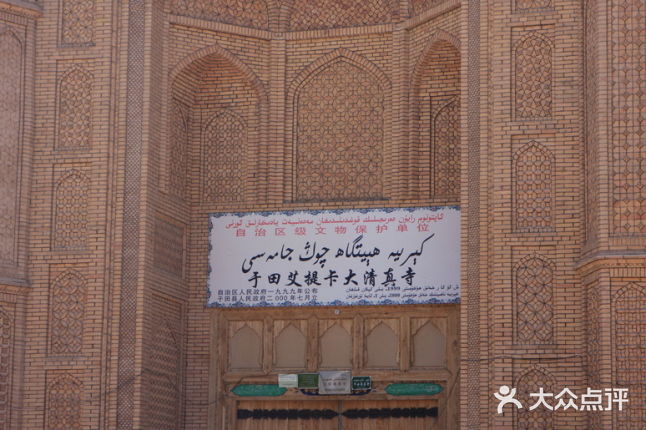
The Imams and the preachers of the mosque faced the same fate as the mosque. We have still no information about Husan Kari Hajim, the oldest Imam of the mosque, after he went missing in 2017. Imin Damollam received a life sentence in 2017. He was a graduate from the first cohort of the Xinjiang Islamic Institute and was assigned to the Keriya mosque as Imam by the government in 1992.
The tragic reality of these historic mosques and government-appointed Imams tells us how dangerous and urgent the current situation is in the Uyghur region. We have to stand up to save the rest of the mosques, our culture, Uyghur heritage and our religious leaders.
Kargilik Grand Mosque
History
According to the Islamic Association of China Uyghur language website,26Islamic Association of China, July 26, 2014, “Qaghiliq Jamesi” http://mu.chinaislam.net.cn/zongjiaoyushenghuo/qingzhensi/201407/0HB5012014.html the Grand Mosque in the city of Kargilik, located between the Yarkand and Hotan, was built 466 years ago during the Yarkand Khanate. It is 4,762 square meters and can hold 10,000 worshippers within its walls and the square in front of it. A bazaar was historically located in front of the mosque, providing a place for trade and religious activity. This mosque also has protected status as a piece of cultural heritage and was the main landmark in the city.
During his reign, Abdurashid Khan placed an emphasis on education and literature as well as developing water systems, roads and transport and strengthening the military and political institutions. One of his advisors was Muhammad Sherif Hoja, a well-known thinker who had studied in Samarkand. Due to its importance as a stop on the road between Hotan and Yarkand, Muhammad Sherif Hoja decided a mosque should be constructed in Kargilik, and the Sultan approved its construction in 1543 CE. According to local history, during its construction the wall facing the Qibla- the direction facing the Kaa’ba in Mecca- fell three times. When the foundations were opened, a jar of gold and human remains were found. They belonged a mullah from the city of Hormuz in Iran, and he was given a proper burial in the mosque compound. The Sultan decreed that the gold would go towards the construction of the mosque.
Expansions took place in 1883, with a madrasah added toward the north side on the advice of Mutulla Ali Mahunum, one of the most prominent Islamic scholars of the time. In 1936 under the leadership of Haji Shenjang, a Hui Muslim, the gatehouse was expanded, and 18-meter tall minarets were added, as well as glass windows and porches to the prayer hall. In 1986 donations from the community were gathered to again renovate and expand the building. Electricity and plumbing were added, and the gatehouse was rebuilt using colorful bricks in the Uyghur style with a five-meter high arch with verses from the Quran in Arabic and Uyghur calligraphy carved in gold.

Interview
Alijan Hasan, researcher in Islamic culture, left the region in 2016 and is now living in the Middle East. Interview conducted in May 2019.
The Kargilik Grand Mosque is over four centuries old and it is where the most famous Uyghur religious leader, Ablikim Mahsum Hajim, taught his students in the 1980s. It is a historic mosque that withstood the Cultural Revolution. It did not survive today’s repression.
Ablat Qarim Hajim, the preacher of this mosque, was detained in 2017. He died in custody and later his body was sent to his family. The mosque was demolished in 2018. Qarim Hajim and Mahsum Hajim are the longest serving religious leaders of Kargilik Grand Mosque. Qari Hajim was selected by the government and graduated from the state-controlled Islamic school in Kashgar. He held a diploma given to him by the government and was made unwelcome by some Uyghur Muslims because of his “red activism.”

The destruction of this mosque and the tragic ending of this Imam, who was trusted and decorated by the Chinese Communist Party, shows the kind of a horrific reality dominating the Uyghur region. The Kargilik Grand Mosque was not only one of the most famous religious centers in the region, but it was also an example of the unique Uyghur historical architecture. It was also named a protected historic site by the government. Now they have destroyed a piece of history.
I stopped and prayed at this historic mosque every time I traveled from Kashgar to Hotan or from Barchuq to Guma. The busy market in front of the mosque attracted people to stay longer. Traditional hand carvings in colorful paint on the mosque gate, columns and ceilings, the parasol trees in the mosque yard and the songs of the birds made a beautiful scene. Kargilik Grand Mosque reminds me of all the wonderful experiences in my life while in my homeland. I felt like it was literally demolished in front of my eyes when I saw its disappearance on Google Earth. It made me upset because the Chinese government removed our history and culture.
Aksu Reste Mosque and Other Local Mosques
History
The Uyghur-language journal “China’s Muslims” stated in 2011 that the “size, design, beauty, majesty and quality of the Aksu Reste Mosque makes it one of the most important religious buildings within the city of Aksu.”27Islamic Association of China, October 28, 2015 “Aqsu Reste Jamesi” http://mu.chinaislam.net.cn/zongjiaoyushenghuo/qingzhensi/201510/102Vc92015.html The mosque has been rebuilt and moved over the centuries, with the site of the original mosque now occupied by the regional education department.
The history of the mosque is closely linked to the foundation of the city, originally a rest stop for travelers between Kashgar and Hotan, to other cities. Beginning in 1747 farmers and herdsmen started to settle there, and a local by the name of Zakirahunning proposed that a mosque should be built. It was already being expanded by 1781, led by local elders such as such as Muhammad Sabit Hajim and Ubeydullah Qari. The city continued to expand and was fortified, and in 1888 Molla Nasir Damollam opened a Madrasah in the “old city,” which would send graduates to work for the mosque. By 1895 it was a 1,300 square meter building with an accompanying education center, dormitories, study rooms, ablution area, and madrasah.

Source: Uyghurism.com
The mosque and surrounding neighborhood were damaged in 1945 when Chinese nationalist troops entered the area but was restored by contributions from local elites in 1947. The mosque was moved in 1964 and once again in 1978, when it was moved to the Reste neighborhood, where locals were given only 340 square meters on which to build. The congregation continued to expand, however, and guest houses, showers and other facilities were built. The mosque was once more moved in 2002 due to its standing in the path of a construction project. Under the leadership of the mosque’s Imam, Hatipi Roshen Qari Hajim and the local authorities, a modern style 3,000 square meter mosque was constructed in 2003 in the West General’s Neighborhood with two stories and an unusual six minaret design.

Interview
Ubulkasim Amar, left Aksu in 2015, now residing in the Netherlands. Interview conducted in May 2019.
This is what I know about two demolished mosques in Aksu. The first is Aksu Egarchi Mosque, which was located next to the Aksu Islamic Institute. Ablikim Kari was the preacher and Mamat Kari was the Imam of the mosque. I still remember I went to that mosque for Iftar dinner with my father. I was very sad when I learned that it was also demolished.
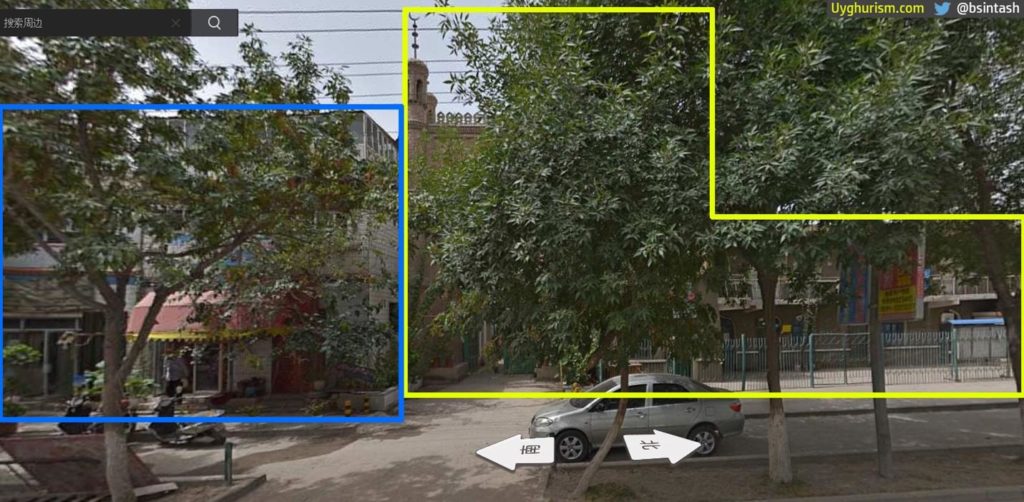

Source: Uyghurism.com
The second mosque is the Aksu Reste Mosque. The Reste Mosque is located on Reste Street and Red Bridge Road. This mosque is the largest mosque in Aksu. Rostam Kari Hajim is the preacher and the Imam is Yasin Damolla. I always went to this mosque to pray because the mosque is in the center of the city. This mosque was demolished by authorities after they detained its Imam and preacher. The act of demolishing mosques on a large scale shows the government’s aim to erase Uyghur culture and religion. I’m very shocked and worried!
I would like to also talk about the Baytullah Mosque where my father was the Imam. Baytullah Mosque is in Yengi Bagh (New Garden) village, community of Dolan, Aksu city. The mosque was rebuilt with the government’s approval at the selected location after the old mosque was demolished in the year 2000. I still remember my father, Amar Mamat, 49, who worked so hard to build this mosque when I was a kid; he built some of the walls of the mosque by himself spending his own free time. Later he teamed up with our neighbors and collected money from home to home in our community. The total money spent for this mosque was more than two million yuan. The labor was provided by volunteers from our community. The mosque became the largest and the main mosque of Yengi Bagh village.

After 2016, the local authorities demolished all the small mosques in the villages and selected Baytullah Mosque as one of five main mosques to be kept for Aksu city under the Xinjiang government’s order to follow the “Mosque Rectification” campaign launched by the central government. My father was detained before the authorities demolished the mosques in Aksu. I have no information about him and on whether he is dead or alive. When I was still living in my hometown, my father told me that the population of the village was about 58,000. Because of the large Uyghur Muslim population of our village, the government was worried about possible uprisings if they demolished or transformed Baytullah Mosque, so they detained all the religious Uyghurs and religious leaders including my father first, before they took the steps of demolishing the mosques in early 2017. Since then, they have demolished hundreds of mosques and transformed some of the mosques into community activity houses to spread Chinese propaganda. The government fully banned people from practicing their religion.
I’m very sad about this unacceptable loss and the crimes against my people, my cultural inheritance and my religion. I worry that my culture could be completely erased under this barbaric destruction. I see darkness when I think about the future. I worry about what our younger Uyghur generation will become without Uyghur identity and faith.
Hotan Id Kah Mosque and Other Local Mosques
Interview 1
Alijan Hasan, researcher in Islamic culture, left Xinjiang in 2016 and now is living in the Middle East. Interview conducted in May 2019.
Hotan Id Kah Mosque is located on the corner of two busy streets. The front of the mosque is always full of people. Many local and non-local visitors pray in this mosque when they come to shop in Hotan. In recent years, many surveillance cameras have been installed inside the mosque and around the mosque. Group prayers were prohibited, and many people have been detained for this practice.

I learned this mosque was demolished in 2017, along with dozens of other popular mosques. The front of Hotan Id Kah Mosque was like the Times Square of Hotan. It took all the happiness and lifestyle with it when it was destroyed. Today that corner is empty, and the people are gone.

Interview 2
Marguba Yusup, nursing student, 22 years old, overseas since 2016 and now residing in Turkey. Interview conducted in May 2019.
I went abroad in 2016. The situation in our hometown changed in 2014. It was not without repression before then, but at that time the suppression was relatively light. But since 2014, the government has started various forms of arrest. At the beginning, the wealthy businessmen and religious scholars were arrested, and the number was not so great, so it did not attract much attention. It was also because people didn’t know the reason for arrests, because in our hometown, police do not need formal warrants or litigation procedures when dealing with Uyghurs.
After that, the intensity of the crackdown increased. If we wanted to go to a nearby town, we all needed to report to the police. Then we started hearing that “an acquaintance had died in prison from torture,” or “a woman in custody was released from prison after becoming pregnant” The atmosphere of the whole city was weird. At every intersection, police officers carried weapons and monitored the local population. There were armed police at the entrances to mosques. If anyone wanted to enter the mosque, they needed to show their ID card to register. Before, Friday sermons were conducted by local Imams. After the repression began, all the mosques installed TVs and the government broadcast “centralized” sermons on screens. The mosque, which was open 24-hours-a-day before, was closed right after Friday prayers.
Until 2013, the government allowed people to raise funds for mosque construction. For example, the Hotan Id Kah Mosque was created by voluntary contributions from local Uyghurs. Many villages have built new mosques. However, from 2014, the government began a rigorous investigation of the above activities. Families and individuals involved in the construction of the mosques were strictly punished.
One man, Abliz Haji, who was chosen to manage the funds for the construction of the Nurluq Mosque, was arrested in 2015 and forced to confess under torture the names of people who had donated to the mosque. However, he was then handed a 10-year prison sentence for refusing to cooperate with the police. There are many similar cases. I tried to understand why the government would allow these activities in the beginning only to later carry out such a serious purge. I think this is called “a long-term plan for major returns,” so the Chinese police could arrest people for “illegal fundraising.” In Hotan, we have about 200 mosques. The government left some mosques intact not to raise the suspicions of foreign tourists and visiting groups. It is meant to blind their eyes and create the illusion of “religious freedom” in Xinjiang.
Below: satellite imagery comparison of analysis of mosques in Hotan. Source: Uyghurism.com




I think the government wants to put all the people who have been to the mosque, pray, or care for their culture into the concentration camps. The intention is to disappear these people, and for those Uyghurs who are outside the camps, political indoctrination is the norm. The government wants to erase our culture, national identity, and religious beliefs. They want to disappear forever those who are different from the Han Chinese.
In a totalitarian regime, like the one organized by Stalin, architectural decisions are never random. Architecture should be a tool of propaganda, a pure product of the regime. It is for this reason that the Chinese government does not want to leave any trace of Uyghur cultural heritage. They are destroying not only Uyghur architecture, but also the Uyghur language, religious belief. Therefore, the Chinese government is destroying local cultural symbols, including mosques, restaurants with ethnic decorations, and even the Uyghur script from public signs.
Shixo (Wusu) Grand Mosque
Interview
Abide Abbas, 27 years old, residing in Turkey since 2015. Interview conducted in May 2019.

Two months ago, while I was surfing the Internet, I came across an image showing the vicinity of the Grand Mosque in my hometown of Shixo (Wusu in Chinese). This mosque is supposed to be situated in a Hui Muslim neighborhood in Shixo, but from the image I could see that it had been totally demolished. The once recognizable minarets of the mosque can no longer be seen. I could not believe my eyes, so I kept on opening and re-opening the image. The two recognizable shops next to the mosque are exactly the way they were; however, the mosque itself is gone.
Seeing an image like this is like the feeling one gets when losing a mother, so tragic, painful and traumatizing. Should I accept or reject this reality that is right before my eyes? I lost myself. I wept looking at the “Mosque-less” image with a history spanning more than a hundred years. It is as if the mosque had never been built. It has now been wiped out. I was saying to myself “curse the CCP.”
I did not realize the value of this mosque until it was taken away from me. I decided to immediately get onto Google to try and find the mosque. When I eventually did, I was met with both before and after destruction images of the mosque. The differences in the images were immense. I could not control myself and my phone fell out of my hands.
I knew I had to accept this tough reality. After receiving this news, I felt that I needed to find out exactly when the mosque was destroyed. I did as much digging as I could, and I found that this mosque was demolished in 2017. At that time, I was studying at al-Azhar University in Egypt and the Chinese police arrested my father. The rest of my family deleted me from the social media app WeChat to protect them from arrest because of their association with me. The Grand Mosque was always such a precious place. The Athan, or call to prayer, could easily be heard at home. The distance from my house to the mosque was approximately 500 meters. Whether it was going to school or going on an errand, I would pass the mosque many times every day. Near the mosque is a small bazaar, with restaurants, a bakery, grocers, an ice-cream parlor, a newsagent, a spice store. Almost everything could be found there. As soon as the Athan was called, everyone would be eager to go and leave together. People conversed in front of the mosque and I can imagine the atmosphere of that place even now.
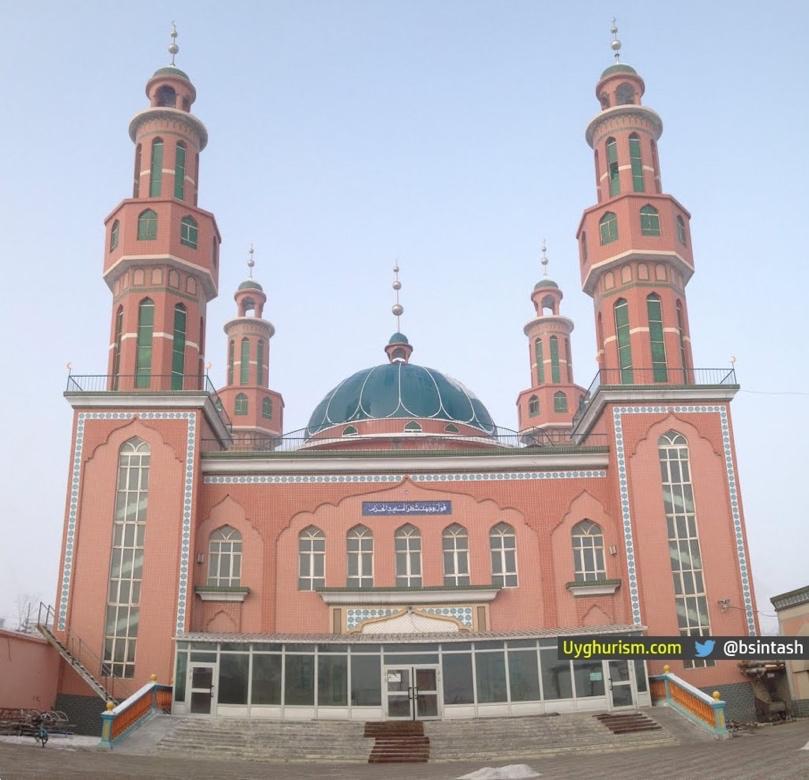
During the Kurban and Ramadan Eid festivities, the sound of the naghra drum would bring happiness and joy to all in front of the mosque. Around 2008, I heard my father talk about how the mosque was going to be renovated. “Today during the Friday sermon, the people were asked to gather funds for the renovation and that a charity box was set up within the mosque’s quarters. We should provide as much as we can,” he said. After leaving my hometown in 2012, the second level of the mosque was finally completed. The atmosphere of the area was refreshed and revamped. I really wanted my father to see it, but at that time he was in prison for “separatism.” Not too long after that, I went abroad, and I never saw that mosque again. I have become a witness to this tough reality of my historical hometown, Shixo, its holy mosque destroyed, a people dispersed, desecrated and disgraced. Could it get any worse than this?
Artush Eshtachi Grand Mosque and Other Mosques in Artush
Interview
Abduwaris Ablimit, 35 years old, left Artush in 2005 and now residing in Boston, Massachusetts. Interview conducted in May 2019.

Since July 2017, my father, Ablimit Amat, my mother, Buhalqam Yusuf, and my younger brother, Zahirshah Ablimit have been detained in China’s concentration camps in my hometown of Artush, Xinjiang. The reason they were detained, I believe, is simply because they practice Islam and pray often. China has locked up many Uyghurs and other Muslims in camps and jails for this kind of reason.
Recently, I heard another piece of sad news from my friend about the demolition of our neighborhood mosque named Bastaggam, a large and impressive place of worship. Bastaggam was the mosque that I always went to pray for Eid and Friday prayers with my father. At the time when I heard the news, I couldn’t believe it. I checked Google Earth and found out that the mosque really did disappear from its location! Then I searched for other mosques in the neighboring villages near my home, unfortunately I found that some large mosques in Kichigiz, Eshtachi, and Bvghan villages were also gone. New homes were built on some demolished mosque sites.

Some of my friends from my hometown Artush who are currently living in bordering Kyrgyzstan on the eastern side of Artush, told me that hundreds of mosques have been demolished and only two thirds of mosques are left in Artush city. I also heard the imams, who were assigned to those mosques by the government over the years, were all detained.
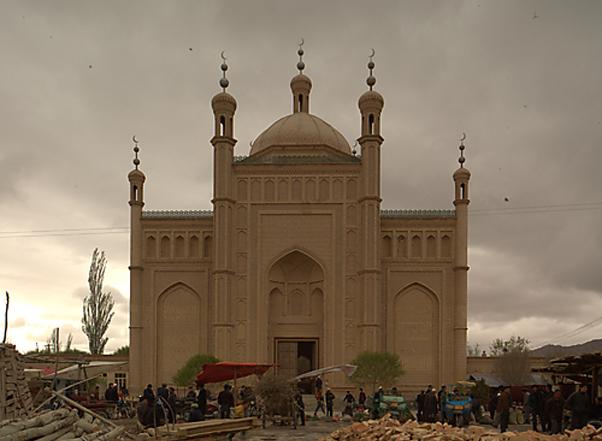
This includes Akbar Hakim Kari, the imam of the demolished Bastaggam Mosque, Bugda Yusufjan Kari, the imam of the Islamic school Tijan Medressah, and Yusufjan Damollam, who is a graduate from the Islamic Institute of Xinjiang and the imam of the demolished Eshtachi mosque in Upper Artush. These facts show that all around Artush most of the mosques are demolished and anyone who has a basic knowledge of Islam is detained. This truly proves what one of my friends, who recently escaped overseas from Artush, told me: “Islam is completely banned in Artush. If you pray, you will end up in jail.”

Maytag Grand Mosque
Interview
Qasimjan Qadir, former technician of Maytag Oilfield in Karamay, now an internet cafe owner in Istanbul, Turkey. Interview conducted in May 2019.

Source: Uyghurism.com
The Maytag Grand Mosque was built about 15 years ago and the size of the mosque is big. It has a two-levels, including a preparation room for bodies before burial, body embalming rooms and a funeral room. The gate of the mosque and the main building was constructed by master builders hired from Kashgar. The interior and exterior of the mosque are all handcrafted using brick and other original material from Kashgar. You can easily see a lot of work was done for this very outstanding building. It became a place to visit and was emblematic of the architecture that can represent Uyghur Muslims of Karamay’s Maytag region.
The mosque is located on a busy street in the main Uyghur community area of Maytag. There is a market area in from of the mosque that many people go to for shopping and relaxing. It’s not only a place where Uyghurs love to go, but also a destination for all of Maytag’s residents, including Chinese and other ethnicities.
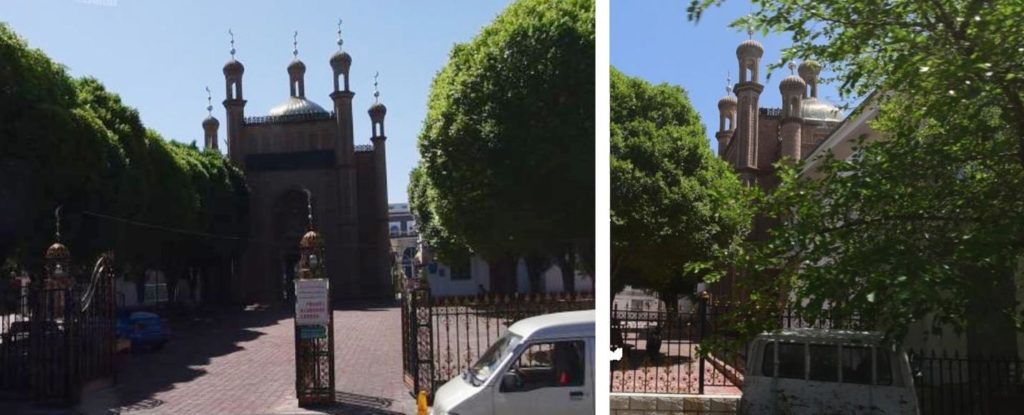
Our local government assigned Alim (last name is unknown), who is a young Uyghur imam, to Maytag Grand Mosque after they trained him at a state controlled Islamic Institute. Alim also met with Xinjiang Communist Party Secretary Zhang Chunxian in person. The Imam was a very nice person, and he built a good relationship with our Uyghur community. The mosque was built using foundation money collected by all Uyghur community members in Maytag; it was not government funded. We only had one small mosque before and there wasn’t enough prayer space for our community, so we collected money and built this one.
I left with my family from Maytag and moved to Turkey in 2014. Since then I haven’t been able to return to Maytag. In 2018, I heard that both the new mosque and the old mosque were demolished, and I couldn’t believe it when I heard the news. Why did they demolish a brand-new mosque that we spent a lot of money on and a lot of time to build? They demolished our only mosques in Maytag. Such an evil thing they have done! Now where can our people pray for Friday and Eid prayers? Where can people hold funerals? This is a very sad situation. I was very proud of having our new mosque because it was the most beautiful mosque I have ever seen in my hometown.
Dorbuljin Mosque
Interview
Aynur Yimit, left Xinjiang in 2015, now living in Istanbul, Turkey. Interview conducted in May 2019.
Dorbuljin Mosque was re-built in September 2011 under the leadership of my 86-year-old father Yimit Abdukeram. The mosque was built with full government approval, and a total of 7 million yuan was spent on the project. 3 million was contributed by my father, with the rest funded via the Uyghur community in our village. Building a large and beautiful mosque for his people was my father’s lifetime goal.
The government’s requirements for the re-building of the mosque were: (1) Not to expand beyond the space taken up by the original mosque. Less than the original size is acceptable, but not more than the original, not even by 1 cm. (2) The mosque’s exterior cannot be more impressive than the government’s buildings, the court and judicial buildings. No granite for exterior finishes. (3) The height of mosque’s minarets must be lower than 13 Meters (42 feet). Due to this regulation, and the difference of regulations between the city and county, they had to cut the miraets of the mosque two times.
Eventually, the mosque construction was complete with a 760 square meter prayer hall and a 560 square meter basement funeral ceremony hall. Because the authorities didn’t let us use granite for the exterior finish, we spent more money for special handmade bricks; the same used for the Grand Bazar exteriors in Urumchi. The mosque’s interior work was finished in 2016. In the same year, Pahirdin Damollam, who is the Imam of our mosque, and two of the young hand carving workers we hired from Kargilik, were detained.

Source: Uyghurism.com
Dorbuljin My father is 86 years old and he owns a family business. In July 2017, the authorities demolished the mosque in front of my father, and they forcibly shaved my father’s beard. They also detained my 52-year-old brother, Ghini Hamit, and my 31-year-old younger brother, Shamshidin Hamit. They took them to the detention camps. My father is very old and not in good health, so they didn’t detain my father. I’m not sure if my brothers are still in the camps or sent to jail. The only thing I know is that they were detained. My older brother is in bad medical condition. I have completely lost connection with all my relatives back home. I don’t know how many of them are currently detained.
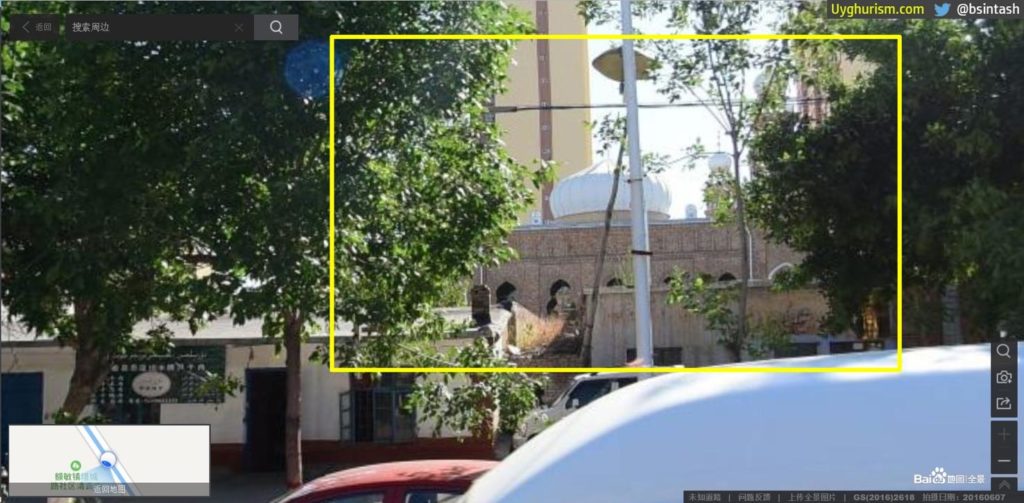
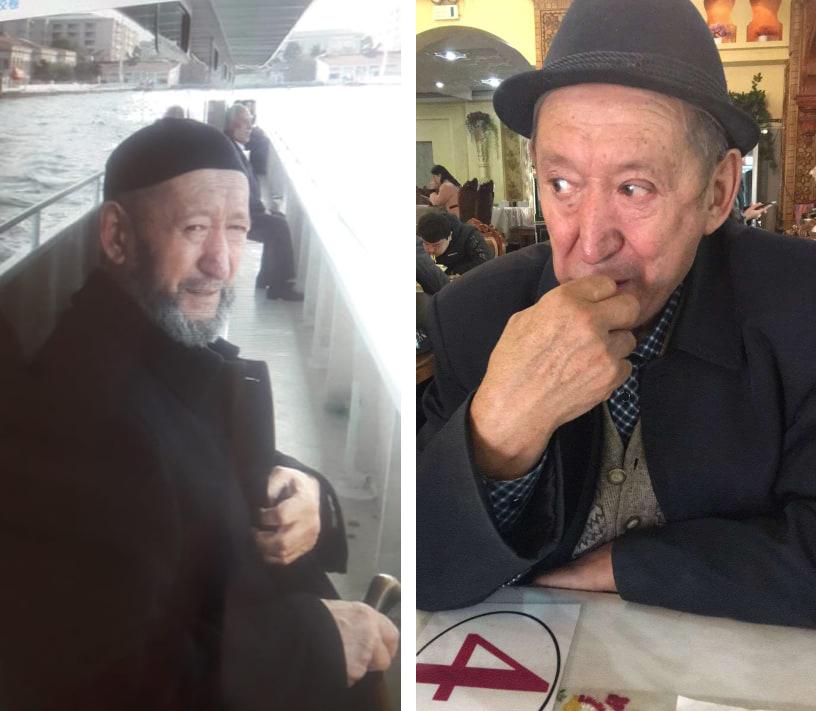
The picture on the left was taken in 2015 and the picture on the right was taken in 2017.
In 2017, I saw a picture of my father after they demolished the mosque and before I completely lost contact with him. In the picture, my father looked like he had lost his soul. The picture made me cry for days. My father also built a cemetery for his community, but I don’t know if it’s still there or if it is also demolished.
My father only wanted to do the best he could for his people and community. He rode his old bicycle and never bought a car because he told us he wanted to buy a funeral car for the mosque. He was the father of our village. He always donated money to low income neighbors and orphans. He was our role model because he did what he could for his people.

IV. Demolished Cemeteries and Shrine
The widespread destruction of Uyghur cemeteries is part of the campaign of eradication of Uyghur holy sites. An AFP and Earthrise Alliance investigation identified at least 45 cemeteries destroyed since 2014, 30 of which had been destroyed since 2017.288AFP, October 9, 2019 “Satellite images reveal China is destroying Muslim graveyards where generations of Uighur families are buried and replacing them with car parks and playgrounds ‘to eradicate the ethnic group’s identity’” Daily Mail https://www.dailymail.co.uk/news/article-7553127/Even-death-Uighurs-feel-long-reach-Chinese-state.html Some have been transformed into parks or parking lots, while others remain empty lots; AFP reporters saw human remains left at several sites. Rachel Harris, an expert on Uyghur culture at the University of London, stated that “[f]rom the destruction of holy shrines, the tombs of saints, to the destruction of tombs of families, all of this is disrupting the relationship between people and their history, and the relationship between the people and the land that they live on.”
Sultanim Cemtery
Interview
Abdul Hemid Abdullah (Kari Hajim) Uyghur scholar who left Hotan in 2014 now living in Istanbul, Turkey. Interview conducted in June 2019.

The Sultanim Cemetery has a history of over 1,000 years. King Sultan Satuq Bughra Khan of the Kara-Khanid Khanate (999–1211) conquered Hotan (the Buddhist Kingdom Udun at that time), and spread Islam around 960 AD. During the conquest, four Kara-khan commanders, including Prince Sultan Kilich Khan, were killed and Muslims buried them at this location. Since then, the cemetery has been known as Sultanim Maziri (My Sultan Shrine) and became one of the most important cemeteries among Uyghur Muslims who have paid their respects here for over 1,000 years. In the center, the four commanders’ graves were still there until China completely bulldozed the entire cemetery in 2019. Many religious leaders, scholars and other important people in Hotan’s far and recent history have been buried in this cemetery.
My father and my grandfather were also buried in this cemetery. The cemetery stopped receiving new bodies about 30 years ago when there was no burial ground left. Over hundreds of years people used each grave for multiple bodies by heaping skeletons to the side and reusing the same grave, as well as by digging down to open multiple levels of grave space underneath an old one. A few million Uyghur bodies were buried under this thousand-year-old cemetery.
I saw a picture on the internet of the notice about the moving of the Sultanim Cemetery and was shocked and angered! How can they move a historic cemetery with so many graves in such a short time frame? The post only gave three days, March 18 to 20, 2019; and announced that anyone wanting to move any graves from the cemetery has to register within that timeframe. If the owners of the graves didn’t come and register in the fixed time given, then those graves would be removed as unclaimed. I had no idea which relatives of mine could go for the registration to move my father’s and grandfathers’ graves. Many relatives of mine are detained in concentration camps and this is a common situation among all other grave owners. I completely lost connection with my relatives in Hotan. And I saw this note almost 3 months after the post.

How can we identify anyone responsible for the hundred to thousand-year-old historic figures resting in the cemetery? No one can go up against what China is doing in Hotan and elsewhere in our hometown. Digging a grave is a hard job; it can take two people a couple of days and costs about 5,000-10,000 yuan (800-1600 US dollars) to dig one grave, especially in Hotan and Sultanim Cemetery. The surface layer of the earth in that location is very soft, so to reach the harder layers, a grave is dug 5-6 meters or maybe even deeper for the layered graves I mentioned earlier. I think most of the graves ended up as unclaimed graves. China has done this before in Hotan during the Cultural Revolution (1967-1976). They destroyed two historic cemeteries and some parts of Sultanim Cemetery; but due to fear of possible opposition from Uyghur people, the government didn’t destroy it all as they did today. The cemetery was the most important holy place for millions of people to go and visit in Hotan every year.
Tarwizim Cemetery
Interview
Marguba Yusup, nursing student 22 years of age, abroad since 2016, now residing in Turkey. Interview conducted in June 2019.
My grandfather’s grave was in Tarwizim Cemetery. He was buried next to Rozi Sayit (the most famous Uyghur poet in recent history). We have lost contact with our relatives in Hotan. We didn’t know about the destroyed cemeteries until I was informed in June 2019. Our house is very close to Sultanim Cemetery. That cemetery is a very important religious site for Uyghurs. I heard many renowned Imams of mosques in Hotan have been buried in Sultanim Cemetery. Every Thursday, many people came to the Sultanim Cemetery to pay their respects and the streets around the cemetery became a market full of people. Both Tarwizim and Sultanim Cemeteries were not located in any place that needed moving as both have been there for many hundreds of years. We don’t know who would be able to take care of my grandfather’s grave. The Uyghur community in Hotan cares about each other and would have willingly volunteered to help move graves of strangers, especially in this kind of situation, but so many people are being held in camps and people outside worry about being targeted for seeming religious in the government’s eyes. We worry that my grandfather’s grave would end up as an unclaimed grave and that the government will treat his remains as trash. The government does not even care about us and our culture while we are alive, so I don’t believe they would care about the dead Uyghurs inside the graves.

Source: Uyghurism.com
Imam Asim and Jafari Sadiq Shrines
Shrines, or mazars, are among the most important religious sites in the Uyghur homeland, often marking the tomb of a local saint or historical figure. Some lie within towns, often with a cemetery around them, while others are in remote areas of the desert. Traditionally the they were destinations for pilgrims from around the region and the locations of important festivals, some of which drew thousands of worshippers. Rahile Dawut, a Uyghur scholar of the shrines who has been detained in the camps, described their importance in traditional Uyghur religious practice:
“In principle mazar worship involves the activities of worship: reading of the Quran, prayers, offerings of sacrifices and other rituals for the purpose of securing the divine protection of the mazar… Mazar worship is popular among the broad masses of the Uighur people, and has become an inalienable part of their religious belief. Worshippers at the mazars pour out the sorrows and bitterness of their hearts and use different forms to express their needs and wishes…People look on the mazar as a place which can protect them from disaster, where they can pour out their innermost feelings, where they can seek cure for diseases, where their souls can be saved, and also as a place where they can seek pleasure.”29Dawut, Rahile, 2009 “Shrine Pilgrimage among the Uighurs” The Silk Road Foundation https://edspace.american.edu/silkroadjournal/wp-content/uploads/sites/984/2017/09/Shrine-Pilgrimage-Among-theUighurs.pdf
The authorities’ fear of large numbers of Uyghurs congregating together and their desire to discourage Uyghur religious observance led them to ban the festivals and to close the shrines to visitors. In its report “Extracting Cultural Resources,” UHRP described the significance of shrine festivals as platforms for the performance of Uyghur music and dance, and the systematic closures of shrines across the region.30UHRP, June 12, 2018 “Extracting Cultural Resources: The Exploitation and Criminalization of Uyghur Cultural Heritage” https://docs.uhrp.org/pdf/CulturalResourcesIntangibleHeritage.pdf Now two major shrines, the Imam Asim and Jafari Sadiq, are among the religious sites that have been destroyed by the Chinese government.
The shrine of Imam Asim is the tomb of a leader who died in the eleventh century during a battle with the Buddhist kingdom of Hotan. According to Rahile Dawut, the festival which took place there once represented a more positive attitude of the government towards shrine festivals. The local government “recognized its tourism potential” and built a road to the shrine. The 20,000 people who attended helped bring revenue to the town.31Dawut, Rahile, 2007 “Shrine Pilgramage and Sustainable Tourism Among the Uyghurs: Central Asian Ritual Traditions in the Context of China’s Development Policies” in Situating the Uyghurs Between China and Central Asia. Ashgate

The festivals at the Imam Asim and Jafari Sadiq shrines were among the last to be banned. According to scholar Rian Thum, the festival which took place in May and June at the Imam Asim shrine was allowed to continue until 2010, but when he tried to visit in 2013, the police were preventing people from visiting.32Thum, Rian, 2014 “The Sacred Routes of Uyghur History” Harvard University Press The festival at the Jafari Sadiq shrine had in previous years been strictly controlled, with pilgrims being required to register with police and pay high entrance fees. Although Thum was uncertain of its status at that time, it seems likely that it was among those shut down at this time.
The mosque and other buildings at the Imam Asim shrine disappeared in satellite photography between March 9 and 17, 2018, leaving the tomb as the only structure at the site. At the Jafari Sadiq shine, the tomb as well as surrounding buildings were also leveled in March 2018. Remarking on the destruction of these shrines, Rian Thum told the Guardian “[n]othing could say more clearly to the Uighurs that the Chinese state wants to uproot their culture and break their connection to the land than the desecration of their ancestors’ graves, the sacred shrines that are the landmarks of Uighur history.”33Kuo, Lily, May 6, 2019 “Revealed: new evidence of China’s mission to raze the mosques of Xinjiang” the Guardian https://www.theguardian.com/world/2019/may/07/revealed-new-evidence-of-chinas-mission-to-raze-themosques-of-xinjiang


V. Demolished Domes and Minarets
The Chinese government has not only been demolishing mosques but also eliminating the Islamic architectural features of many of those which remain standing. UHRP has previously written about the authorities’ recent campaign against “foreign” design elements in the architecture of mosques and other buildings as part of the campaign to “Sinicize” religion.344UHRP, May 9, 2018 “Briefing: Chinese Government Accelerates Assimilative Policies in “Sinicization of Religion” Campaign” https://docs.uhrp.org/pdf/ReligionWhitePaper.pdf According to reports, Uyghurs have been forced to remove any traditionally Islamic architectural elements such as mihrabs from their private homes as well, with directives on proper aesthetics being issued and inspections conducted to ensure that Uyghur homes meet them. A village Party Secretary from Hotan prefecture told Radio Free Asia that in the city “no buildings considered to exemplify classic ethnic characteristics have been left untouched.”35Hoshur, Shoret, October, 10, 2019 “Uyghurs Ordered to Destroy Muslim Architecture Deemed ‘Extremist’ by Authorities” Radio Free Asia https://www.rfa.org/english/news/uyghur/architecture-07102019140830.html
The building pictured below is the Bahar Department Store, located near Hotan Square in the center of the city. It was built around 2007 by Eli Hajim Horaz, a Uyghur real estate investor. Hajim and many of his family members have been detained, part of a pattern persecution of wealthy Uyghurs. Its dome was the biggest in the Uyghur region at 20 meters in diameter, only 5 meters smaller than the dome on the Taj Mahal in India. It was concealed in an octagonal structure in 2017 and completely removed in 2018. The “after” picture shows Hotan Communist Party officials shouting slogans among hundreds of cadres at a rally of Party members against “the three evil forces” and “two-faced people” on August 28, 2017.36和⽥市电视台 August 29, 2017 “和⽥地区召开全⾯深入推进党员⼲部发声亮剑⼤会” 和⽥市政府⽹ https://www.hts.gov.cn/bendixinwen/show.php?itemid=727
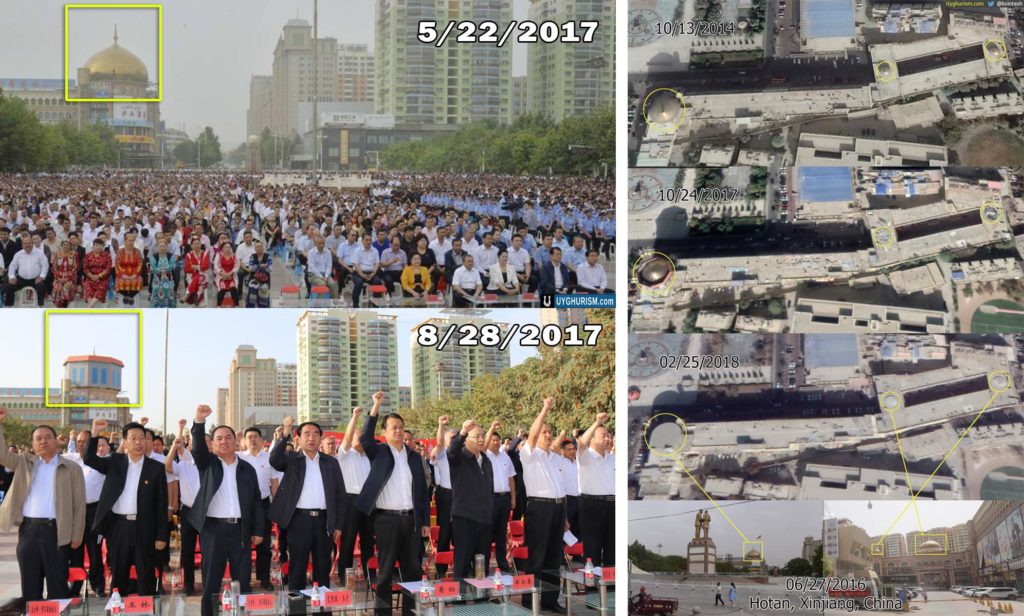
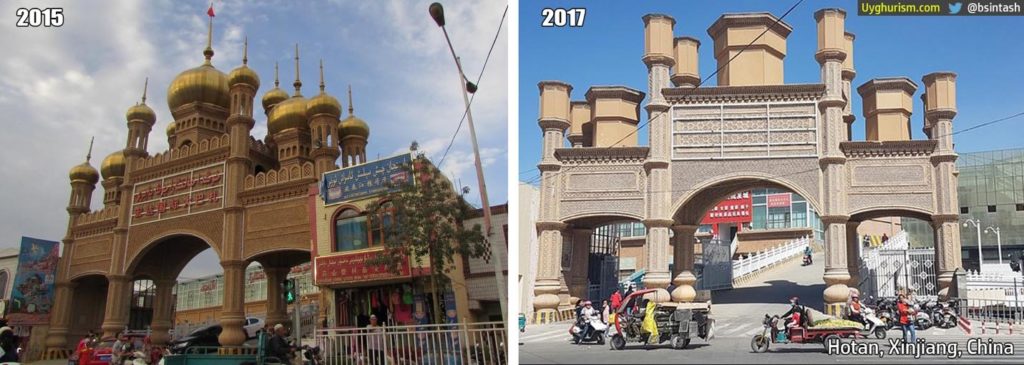
Below are two pictures of a mosque with and with its dome sent via Twitter as a direct message to Asiya Uyghur by a Han Chinese official who came to Xinjiang from inner China. Asiya Uyghur, who lives in the Netherlands, shared these photos via Facebook on May 5, 2019. Asiya Uyghur is a pseudonym; she declined to share her actual name at this time. According to Asiya, the Han Chinese man asked her to publish these pictures on her social media pages without mentioning his name or the year the pictures were taken for his own safety. According to Asiya, the Chinese official told her the two photos were taken 6 days apart. They were likely recently taken somewhere in the southern part of the Uyghur region.
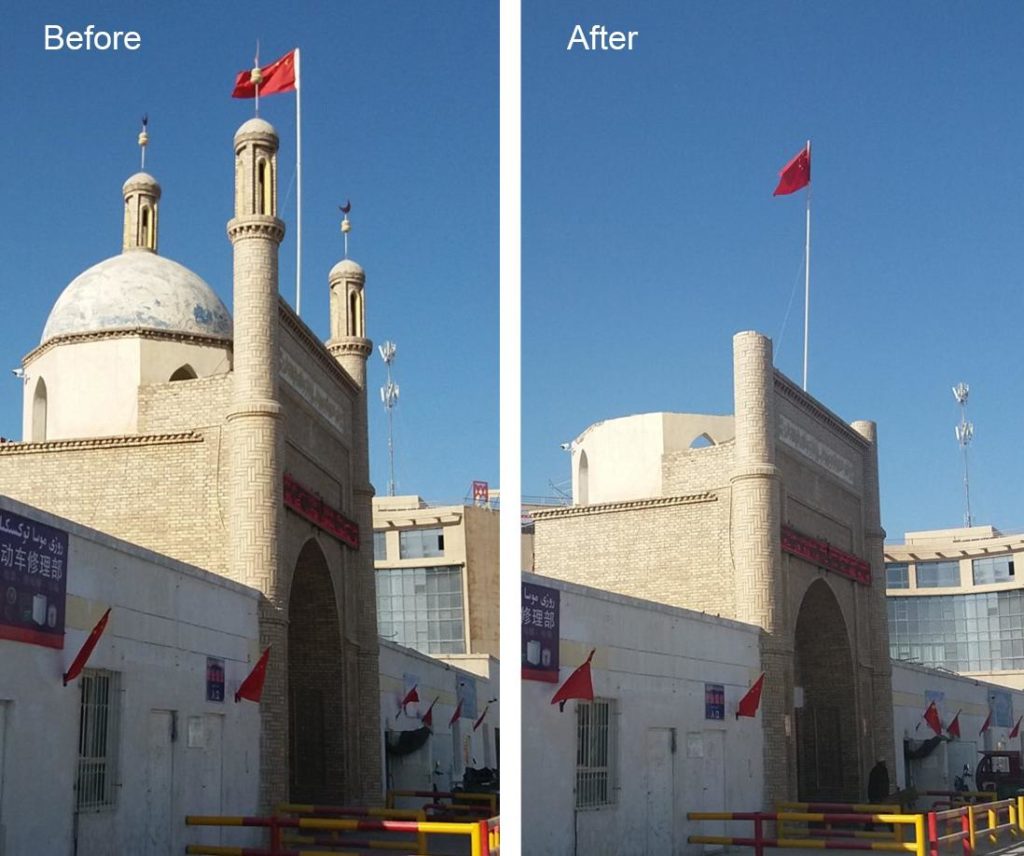

The before and after satellite images of the Gulbag Department Store above show that the domes of the building were removed in 2017. In June 2019, AFP reporter Pak Yiu, who was visiting Hotan city with a crew for a report on Ramadan in the Uyghur region, informed Bahram Sintash that the local people reported to him that the 99-meter high tower of the Gulbag Bazaar was also slated to be demolished. The building was built by Uyghur real estate investor Kudirat Hajim, who died in 2015. His cause of death is unknown.
Below are examples of architectural features removed from two mosques on Aya (阿牙)Street in Kumul. Source: Uyghurism.com


Below: satellite imagery comparison of commercial buildings around the square in front of the Id Kah Mosque in the center of Kashgar. Source: Uyghurism.com
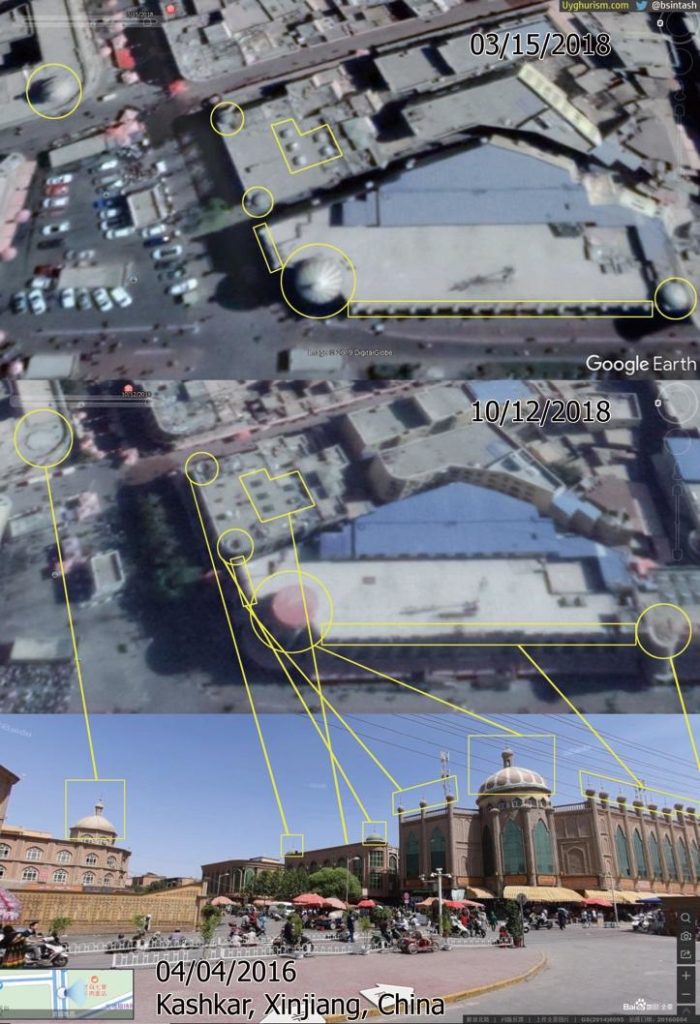
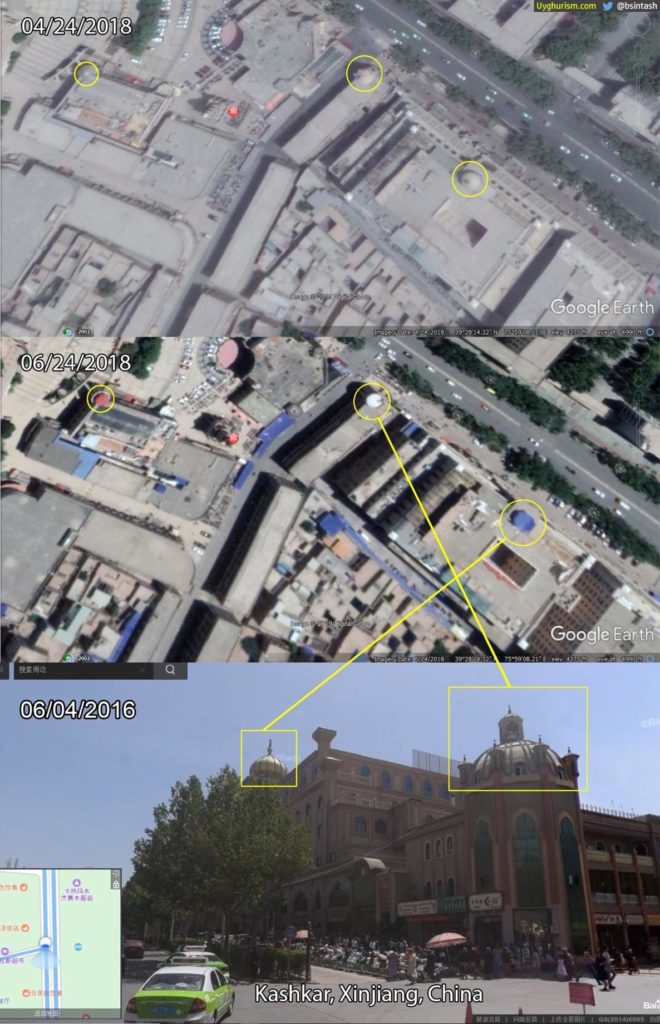

VI. Analysis
Q and A Between UHRP and Bahram Sintash on the Findings
UHRP: Are there too many mosques for Uyghur Muslims and other Muslim ethnicities as China claims?
Bahram Sintash: On the world’s stage, China claims that they are protecting Uyghur and other minorities’ religious rights. They support their claim by citing the existence of over 24,300 mosques in the Uyghur region.37Information Office of the State Council of the People’s Republic of China, September 21, 2009 “Development and Progress in Xinjiang” http://www.gov.cn/english/official/2009-09/21/content_1422566.html This is a baseless claim.
According to state reports, there were more than 13,000 mosques when the CCP took power in 1949.38Abduriheym, Hasan, 2015 “Xinjiang Islam Binakarliki” Xinjiang People’s Publishing House There were 126 mosques in Kashgar city alone, with the city having a population of 40,000 Uyghurs at the time. In the early 1950s, the total Uyghur population was more than 3.65 million and the population of other Muslims, such as Kazakh, Hui and Kyrgyz, was approximately 750,000 (the Han Chinese population in the region was about 292,000). This amounts to roughly 1 mosque per 338 citizens.
In the ten years of Cultural Revolution (1966-1976), a lot of cultural relics and architecture, including mosques and other religious sites, was demolished under the guise of uprooting the “old ways of thinking.” There was extensive damage done to famous mosques and shrines. There is little research on how many mosques and other religious sites were demolished in the region during this period.
Since 1980, some old historical mosques were repaired, and many new mosques were built; many of those mosques were given protection site licenses by the government. After 2000, more new mosques were built across the region, or old mosques improved upon via funding provided by the Uyghur community and Uyghur philanthropist business owners who had become wealthy after China’s open-door economic policy.
The official number of mosques has doubled since 1950, while the Uyghur population has tripled according to official data. Taking into account the 1.8 million Kazakh Muslims, 1 million Hui Muslims, and 200,000 Kyrgyz Muslims, the total Muslim population in the region is about 14.3 million. When calculated, it is easy to see that while there were 338 Muslims per mosque in the 1950s, in 2015 there were roughly 588 Muslims per mosque. Compare this to Pakistan, which has 1.3 million mosques for a population of 197 million, or 1 mosque per 148 people.
UHRP: What is your estimate of the number of mosques destroyed?
Bahram Sintash: The Uyghur region’s territory is divided into 14 prefectures, 4 prefecturallevel cities, 99 counties, 24 county-level cities, and 1,337 townships and 13,446 villages. The Uyghur region is the largest Chinese administrative division, spanning over 1.6 million square kilometers, equaling 4.47 times Germany’s land mass.
Distances between villages and towns are far, and it is not easy for Muslim farmers to go to the town centers and neighbor villages for everyday prayer. That is why of the 24,300 mosques and other religious sites are in the region many are smaller mosques in villages for everyday religious practices, funeral services and other religious activities.
Some media reports quote local residents estimating 80% of mosques in towns and villages have been demolished.39Kuo, Lily May 6, 2019 “Revealed: new evidence of China’s mission to raze the mosques of Xinjiang” the Guardian https://www.theguardian.com/world/2019/may/07/revealed-new-evidence-of-chinas-mission-to-razethe-mosques-of-xinjiang This matches what was told to me during interviews I conducted with Uyghurs living overseas who had left towns and villages in different parts of the region after 2017. I believe these small village mosques are the majority of the demolished mosques. For one example, In the town of Changji, I found 3 mosques completely demolished and 12 mosques with their domes and minarets removed. All of the mosques in this small city were affected. I believe that if you take a conservative estimate that 80% of the mosques around the Uyghur region have been affected, that would mean that as many as 10,000 to 15,000 mosques have been affected by the campaign. This includes both those that have been completely and partially demolished, as well as those with architectural elements removed. Based on this and my survey of mosques in towns and cities around the region, I believe that 10,000-15,000 is a reasonable estimate of the number of mosques affected.
Large mosques in townships and cities were demolished all around XUAR as well. So far, I have discovered up to 140 mosques which have either been fully or partially demolished or had architectural features removed. Information from my sources from the region and through my examination of over 400 religious sites about 30-40 percent of mosques were demolished in each township, in major counties and cities all over the Uyghur region since 2017. Because of the percentage of Uyghur Muslims in the North versus the South, more mosques were demolished in the southern part of the Uyghur region.
UHRP: Why did China keep some iconic mosques in major cities from being destroyed while demolishing others?
Although China demolished some small and large mosques in major cities, they left some alone in cities such as Korla, Kashgar, Urumchi and Ghulja. In one instance, I found that while there is evidence of three large mosques being demolished in Korla city, the Korla Jama Mosque, the largest and the oldest in the city, has survived. Authorities, however, have removed all the domes and minarets from the historic mosque, symbols representing Islam as well as the arches above the windows. According to my research on the Korla Jama Mosque, this mosque is one of the “selected” tourist destinations of Korla city. Therefore, the government kept the Korla Jama Mosque not for the sake of local Uyghur Muslim communities and their prayer needs, but as preselected tour locations to show as evidence of the government’s “protection” of Islam in the city, to lie to the international community and reporters.

According multiple Chinese tourists’ posts on Chinese tourist apps and websites,40Mafengwo.cn “加麦⼤清真寺”, http://www.mafengwo.cn/poi/33667500.html?mfw_chid=2762-5630961 the Korla Jama mosque is one of the major tourist destinations in Korla. According to one tourist’s post the Korla Jama Mosque’s name has changed to the Korla Unity Road Mosque.411Qunar.com “加麦⼤清真寺” https://touch.travel.qunar.com/comment/10157324939 A large sign with the new name was installed after the Islamic script on top of the mosque’s main gate were removed. Another tourist wrote that they never saw the mosque open and they were not able to go inside.42Qunar.com “加麦⼤清真寺” https://touch.travel.qunar.com/comment/10158813429 Their pictures show high tech security gates at the entrance of the mosque and CCTV cameras.
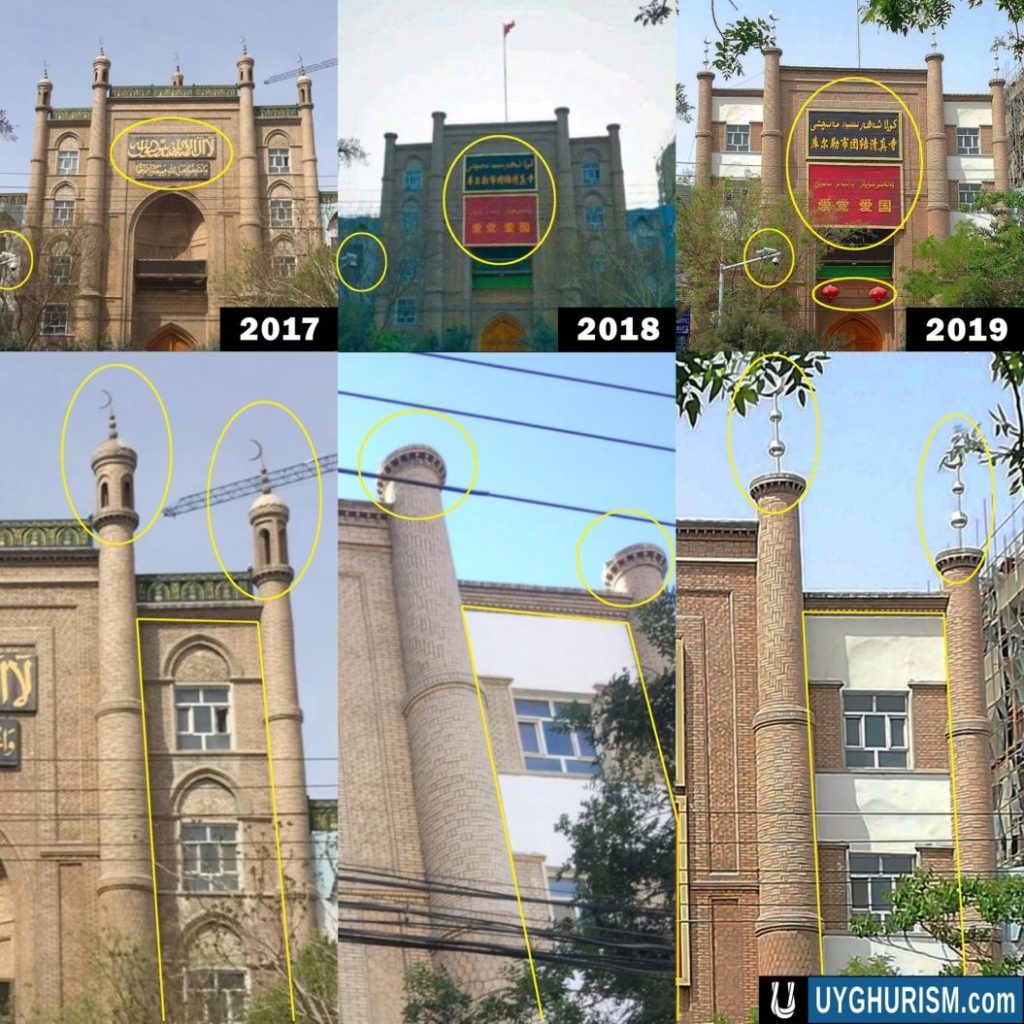
Interestingly, though the authorities have removed all the domes and minarets with their crescent moon symbols in 2018, in 2019 new crescent moons were added on top of the dome bases in a manner inappropriate to traditional design. Authorities reinstalled these symbols of Islam on the mosque to deceive international delegations or foreign reporters because of this mosque’s size, long history and status as a tourist destination. However, it seems this mosque no longer serves Muslim community in Korla like before.
Mosques not serving a tourism purpose have been demolished. The Towanki Darwaza Mosque and the Ah Mosque, two mosques which are also in Korla, disappear from the satellite imagery in 2018. Smaller mosques like these can be demolished with less international attention.




According to my research, since 2016 fewer mosques have been demolished in Kashgar and Yarkand cities compared to Hotan city. All three cities are the most ancient, populated and religious cities in the southern part of the Uyghur homeland, with a population of mostly Uyghur Muslims. Hotan city was the hardest hit, with 14 midsize to large mosques demolished within the city alone. Hotan could be the most destroyed city in terms of wrecked mosques, cemeteries and Islamic architecture. Only one historic mosque, the Hotan Jama Mosque, has survived in the city for tourism and other purposes.
Both Kashgar and Yarkand were capital cities of two different Uyghur kingdoms during different historical periods. Some historic and religious architecture survived over hundreds of years and during the Cultural Revolution (1966-1976). Since China has opened its doors to international tourists in 1980, these cities have become the best tourist destinations in the Uyghur homeland.
Beginning in 2009, the government demolished and replaced old buildings and homes with modern, tourist-friendly buildings in the city-center of Kashgar. This pattern is being repeated in other cities. This development has significantly changed the beauty of the true and original Uyghur Islamic heritage in those cities. Below are before and after pictures of the Yarkand Palace, part of the complex which includes the Altun Mosque and Queen Amannisa’s Mausoleum. These have been allowed to remain for tourism purposes and to create the pretense of protecting Uyghur culture and heritage to the international community.


Below: Mapio
The evidence I found clearly shows that since 2017 China’s mass destruction of Uyghur Islamic heritage was carried out aggressively in mid-level cities, townships and villages. According to my investigation, many large and historic mosques were demolished in small cities like Hotan, Keriya, Kargilik, Artush and Guma.
In just the small city of Artush, located about 50 miles from Kashgar I’ve found evidence of the destruction of four large mosques. In June 2019, a group of AFP reporters visited Kashgar to report on demolished mosques and the religious atmosphere of Ramadan in the Uyghur homeland.43AFP, June 5, 2019 “Wrecked mosques, police watch: A tense Ramadan in Xinjiang” the Straits Times https://www.straitstimes.com/asia/east-asia/wrecked-mosques-police-watch-a-tense-ramadan-in-xinjiang Before this visit, an AFP reporter asked me for my suggestions and guidance for the trip. I provided a list of destroyed mosque locations that I identified and suggested that they visit small cities like Artush and Hotan, where the majority of the destruction has taken place.
The AFP reporters visited Kashgar and interviewed the head Imam of the Kashgar Id Kah mosque, the most famous mosque in the Uyghur homeland and a very well-known tourist destination. While they were allowed to visit this well-known tourist site, the reporters were blocked from entering the smaller city of Artush. The distance between the two cities is very close, but two different authorities controlled who can visit these cities when it came to reporters and other international community members; this is because the government is trying to hide the reality of this small city; a small city located near a popular and “happy” tourist location.
China is trying to hide the evidence of cultural genocide committed against Uyghurs by blocking reporters from entering small cites, townships and villages; China is also exhibiting an orchestrated atmosphere and opening pre-chosen tourist destinations to show reporters that China is actually protecting Islam and Uyghur culture. China is prepared to deny all the ongoing Islamic and religious crackdown and demolished mosques in the Uyghur homeland.
Background to Religious Repression
In May 2013, UHRP released a comprehensive report, Sacred Right Defiled, detailing the longarc of restrictions on several aspects of Uyghur religious life. Interviews with Uyghurs overseas and secondary source data revealed systematic curbs and controls on religious belief and practice. Notably, the repression primarily targeted intangible dimensions of Islam. Religious leaders, such as imams, were required to attend political education classes to ensure compliance with CCP regulations and policies; only state-approved versions of the Koran and sermons were permitted; any outward expression of faith in government workplaces, hospitals and some private businesses, such as men wearing beards or women wearing headscarves, were forbidden; no state employees and no one under the age of 18 could enter a mosque; organized private religious education was proscribed; and students, teachers and government workers were prohibited from fasting during Ramadan. In addition, Uyghurs were not permitted to undertake Hajj, unless it was with an expensive official tour, in which state officials carefully vet applicants.44UHRP, April 30, 2013 “Sacred Right Defiled: China’s Iron-Fisted Repression of Uyghur Religious Freedom” https://uhrp.org/press-release/sacred-right-defiled-china%E2%80%99s-iron-fisted-repression-uyghur-religiousfreedom.html
Since the release of Sacred Right Defiled, and with the beginning of Xi Jinping’s rule in 2013, religious repression has intensified. The determination to separate Uyghurs from the religious underpinnings of their identity corresponded with the implementation of a “major strategic shift” in the Uyghur region that prioritized “security” policies in the region. These security initiatives claimed a crackdown on the “three evil forces of separatism, extremism and terrorism,” which ostensibly targeted peaceful religious expression.45UHRP, May 8, 2014 “China attempts to criminalize every aspect of Uyghur religious belief and practice” https://uhrp.org/press-release/briefing-china-attempts-criminalize-every-aspect-uyghur-religious-belief-and-practice However, the intensification of religious repression has extended into tangible aspects of Uyghur religious life as demonstrated by this report. The combination of demolitions and indoctrination in internment camps indicates an attempt to erase Uyghur belief in Islam and the Chinese government’s moves to commit an ethnocide of the Uyghur people. This conclusion refutes the Chinese government’s assertation that policies have been designed to “Sinicize” religion within the People’s Republic of China.46UHRP, May 9, 2018 “Chinese Government Accelerates Assimilative Policies in “Sinicization of Religion” Campaign” https://docs.uhrp.org/pdf/ReligionWhitePaper.pdf
Victims of the internment camps who have managed to reach safety have described being forced to renounce belief in God and to praise President Xi Jinping and the Communist Party. They are required to write self-criticisms of their “terrorist” and “separatist” actions, and to pledge to drink alcohol, smoke cigarettes and tell other Uyghurs about the evils of Islam.47Shih, Gerry, May 17, 2018 “China’s mass indoctrination camps evoke Cultural Revolution” Associated Press https://apnews.com/6e151296fb194f85ba69a8babd972e4b Further salient examples of a continuing assault on the intangible facets of Uyghur religious belief include reports of individuals sent to the camps for having attended a wedding or funeral where a religious passage was read;48Atawulla, Muhammad, December 19, 2018 “My Beloved Family Is Broken Apart” Uyghur Human Rights Project https://weblog.uhrp.org/my-beloved-family-is-broken-apart/ the banning of Islamic weddings and burials, as “burial management centers” are set up to prevent traditional funeral rituals, and to enforce cremation instead of burial;49Hoshur, Shoret, April 19, 2018 “Xinjiang Authorities Use ‘Burial Management Centers’ to Subvert Uyghur Funeral Traditions” Radio Free Asia https://www.rfa.org/english/news/uyghur/burials-04192018141100.html a ban placed on 29 names for Uyghur children, such as Muhammad and Fatima, to “curb religious fervor;”50UHRP, May 4, 2018 “Ban on “Islamic” names an absurd intrusion into Uyghurs’ private lives” https://uhrp.org/uaa-and-uhrp-reports-and-briefings-press-releases/briefing-ban- %E2%80%9Cislamic%E2%80%9D-names-absurd-intrusion the launch of an anti-Halal campaign in which Communist Party officials, who are sent to Uyghur homes to monitor their political attitudes, buy and prepare food to test whether Uyghurs will ask what meat is in the dish;51Ablidim, Mihray, November 6, 2018 “Xinjiang’s Kashgar University Students, Teachers Forced to Give up Muslim Dietary Restrictions” Radio Free Asia https://www.rfa.org/english/news/uyghur/halal11062018155848.html & Byler, Darren, October 26, 2018 “China’s Nightmare Homestay” Foreign Policy https://foreignpolicy.com/2018/10/26/china-nightmare-homestay-xinjiang-uighur-monitor/ a ban on using the traditional Muslim greeting of “As-Salaam Alaikum” in regional schools;522AFP, July 13, 2017 “China’s crackdown on Uighur Muslims has turned Xinjiang into a ‘police state’” https://www.thenational.ae/world/asia/china-s-crackdown-on-uighur-muslims-has-turned-xinjiang-into-apolice-state-1.567992 and denial of marriage applications, refusal of service on public transport and evictions based on adherence to the Islamic faith.53Turdush, Rukiye, May 31, 2013 “Two Xinjiang Villages Bar Women From Covering Faces” Radio Free Asia http://www.rfa.org/english/news/uyghur/hijab-05312013175617.html & UHRP August 5, 2014 “Bus ban in Karamay treats Uyghurs as second class citizens and demonstrates open discrimination” https://uhrp.org/pressreleases/bus-ban-karamay-treats-uyghurs-second-class-citizens-and-demonstrates-open & Keyoumu, Guliqiekela, August 27, 2013 “Veiled Muslim Uyghur Woman Evicted from Rented Home” Radio Free Asia http://www.rfa.org/english/news/uyghur/eviction-08272013174741.html

VII. Legal Instruments
International Standards
Article 18 of the Universal Declaration of Human Rights (UDHR), adopted by the United Nations General Assembly in 1948, outlines the individual right to freedom of religious belief:
Everyone has the right to freedom of thought, conscience and religion.54United Nations (UN). December 10, 1948, “The Universal Declaration of Human Rights (UDHR)” http://www.un.org/en/documents/udhr/index.shtml
Individual and collective religious freedom is restated in Article 18 of the International Covenant on Civil and Political Rights (ICCPR), Article 1 of the Declaration on the Elimination of All Forms of Intolerance and of Discrimination Based on Religion or Belief and Article 2 of the Declaration on the Rights of Persons Belonging to National or Ethnic, Religious and Linguistic Minorities (Declaration on Minorities), which states:
Persons belonging to national or ethnic, religious and linguistic minorities…have the right to enjoy their own culture, to profess and practise their own religion.55United Nations (UN) General Assembly November 25, 1981 “Declaration on the Elimination of All Forms of Intolerance and of Discrimination Based on Religion or Belief” http://www.un.org/documents/ga/res/36/a36r055.htm.
At the Forty-eighth Session of the Human Rights Committee in July 1993, General Comment No. 22 on Article 18 of the ICCPR noted:
The concept of worship extends to ritual and ceremonial acts giving direct expression to belief, as well as various practices integral to such acts, including the building of places of worship [UHRP italics], the use of ritual formulae and objects, the display of symbols, and the observance of holidays and days of rest.”56Office of the High Commissioner for Human Rights, July 30, 1993 “CCPR General Comment No. 22: Article 18 (Freedom of Thought, Conscience or Religion)” UN Human Rights Committee https://www.refworld.org/docid/453883fb22.html
Furthermore, UN Commission on Human Rights Resolution 2004/36 on the Elimination of All Forms of Religious Intolerance urges states:
To exert the utmost efforts, in accordance with their national legislation and in conformity with international human rights standards, to ensure that religious places, sites and shrines are fully respected and protected and to take additional measures in cases where they are vulnerable to desecration or destruction.57Office of the High Commissioner for Human Rights April 19, 2004 “Elimination of all forms of religious intolerance” UN Commission on Human Rights https://www.refworld.org/docid/43f3136c0.html
Chinese Law
Freedom of religious belief is in theory permitted under the laws of the PRC. Although provisions protect religious believers from discrimination, the laws are clear that the Chinese party-state is the arbiter of permissible religious practice.
Article 36 of The Constitution of the People’s Republic of China states:
Citizens of the People’s Republic of China enjoy freedom of religious belief. No state organ, public organization or individual may compel citizens to believe in, or not to believe in, any religion; nor may they discriminate against citizens who believe in, or do not believe in, any religion. The state protects normal religious 45 activities. No one may make use of religion to engage in activities that disrupt public order, impair the health of citizens or interfere with the educational system of the state. Religious bodies and religious affairs are not subject to any foreign domination.58http://www.npc.gov.cn/englishnpc/Constitution/2007-11/15/content_1372964.html
Article 11 of the Regional Ethnic Autonomy Law (REAL) codifies the religious rights of ethnic minorities in the PRC and restates the supremacy of the Chinese party-state:
Autonomous agencies in ethnic autonomous areas guarantee the freedom of religious belief to citizens of the various nationalities. No state organ, public organization or individual may compel citizens to believe in, or not to believe in, any religion, nor may they discriminate against citizens who believe in, or do not believe in, any religion. The state protects normal religious activities. No one may make use of religion to engage in activities that disrupt public order, impair the health of citizens or interfere with the educational system of the state. Religious bodies and religious affairs shall not be subject to any foreign domination.59National People’s Congress, May 31, 1984 “Regional Ethnic Autonomy Law of the People’s Republic of China” https://www.cecc.gov/resources/legal-provisions/regional-ethnic-autonomy-law-of-the-peoples-republic-of-chinaamended
The Regional Ethnic Autonomy Law also outlines protections for tangible and intangible cultural heritage in Article 38:
Autonomous agencies in ethnic autonomous areas support relevant departments and bureaus as they collect, organize, translate and publish historical and cultural books of the nationalities, protect the scenic spots and historical sites in their areas, their treasured cultural relics and their other important historical and cultural legacies, and preserve and develop outstanding ethnic traditional culture.60Ibid.
Article 13 of the Law of the People’s Republic of China on the Protection of Cultural Relics calls for the National Key Cultural Relics Unit (全国重点⽂物保护单位) under the State Council to “select, from among the historical and cultural sites protected at the levels of province, city and county, those of significant historical, artistic or scientific value as major historical and cultural sites protected at the national level.”61National People’s Congress, April, 24 2015 “Law of the People’s Republic of China on Protection of Cultural Relics (2015 Amendment)” http://orcp.hustoj.com/?p=3951 Keriya Id Kah Mosque was designated on the national list of protected sites; however, the other sites referenced in this report are not mentioned, even at the regional level.62http://www.china.com.cn/aboutchina/data/wwbhdw/node_7004009.htm & 新疆文物保护网, November 8, 2014 “新疆维吾尔自治区第七批区级文物保护单位名单” https://web.archive.org/web/20161018214616/http://www.xjwwbh.com/quanjiangwenwu/wenbaodanwei/2015/0425/308.html According to the Law of the People’s Republic of China on the Protection of Cultural Relics, sites that have been designated as protected at the national level need approval from the State Council before they can be destroyed.633Standing Committee of the National People’s Congress, November 19, 1982 “Law of People’s Republic of China on the Protection of Cultural Relics” http://www.chinatoday.com/law/china-laws/cultural-relics-protection.htm Or Standing Committee of the National People’s Congress, April 24, 2015., Law of the People’s Republic of China on Protection of Cultural Relics (2015 Amendment, Open Repository on Cultural Property http://orcp.hustoj.com/?p=3951

VIII. Recommendations
To International Actors
- Publicly condemn the Chinese government’s demolition of mosques and religious sites and its arbitrary detention of religious leaders and practitioners in concentration camps.
- Raise the issue of religious freedom at bilateral dialogues with the Chinese government and at international forums.
- Governments should ensure that no Uyghur asylum seeker is refouled to China, and free those being held for illegal entry.
- Assign Ambassadors at Large for Religious Freedom, Human Rights and other relevant domains to investigate religious repression in the Uyghur region, raise the issue with Chinese officials and if possible secure visits to the region.
- The UN Office of the High Commissioner for Human Rights should seek to secure free access to independent observers, including the Special Rapporteurs on Religion or Belief and Minority Issues, as well as to conduct an investigation regarding the situation on the ground, including into the state of religious sites and the detention of religious leaders.
- The UN OHCR Working Group on Enforced or Involuntary Disappearances should arrange a visit to the region to investigate and issue a report on the situation.
- The Organisation of Islamic Cooperation should seek information about the welfare of the detained religious leaders and their families, and request meetings with them.
- Multilateral development banks, including the World Bank, should review ongoing projects in the region and reassess lending to the Chinese government until human rights standards are met.
- Governments and civil society institutions should provide funding for cultural preservation projects, documentation and translation of Uyghur religious and cultural heritage.
- Universities and religious communities should consider providing visiting fellowships for Uyghur religious teachers and scholars who have fled the Uyghur region.
- The next International Religious Freedom Ministerial held by the U.S. State Department should issue a statement on destruction of mosques and detention of religious leaders.
To the Chinese Government
- Cease demolitions of places of worship and religious sites in the Uyghur region and provide compensation for those that have already been demolished.
- Allow the restoration of buildings that have been partially demolished or had architectural elements removed.
- Close the system of concentration camps and immediately release all religious leaders and believers being held in extrajudicial detention as well as those unjustly sentenced to prison for their beliefs.
- Allow independent observers and journalists access to the region.

IX. Methodology
The primary author of this report, Bahram Sintash, is a former Uyghur architectural designer and researcher who has taken on a major role in investigating the destruction of Uyghur mosques, other Islamic sites and Uyghur towns in the Uyghur region. He has presented evidence of over 90 demolished sites on his Uyghurism.com website after analyzing satellite images of hundreds of locations in the Uyghur region using his knowledge of Uyghur architecture and information given to him by Uyghurs overseas.
Bahram Sintash analyzed over 400 mosque locations on multiple satellite image programs, including Google Earth and Planet Lab. Unfortunately, most of the mosque locations in the Uyghur region are not searchable on mainstream search engines such as Google, Baidu and other mapping platforms. Bahram Sintash found almost 45% of the mosque locations by getting help from over 15 Uyghur individuals from different parts of the Uyghur region who are now living overseas. These individuals helped Bahram Sintash identify mosque locations by searching their city or township on Google Maps and sharing the coordinates. Bahram Sintash found some of the mosque locations without assistance by zoom-in-and-search methods that he developed over weeks of searching satellite images. After confirming each demolished mosque site, he captured the most recent and oldest satellite images indicating the disappearance of each mosque. He published the list of demolished mosques and other Islamic sites with before-and-after images, as well as information about each mosque on his personal website, Uyghurism.com.
For this report he selected the mosques most illustrative of the demolition campaign and interviewed Uyghurs with connections to the demolished religious sites to collect context and insight into the reason the Chinese government had demolished the mosques in their hometown. He also gathered background materials from Uyghur sources about the history of the mosques discussed in this report.

X. Acknowledgements
Bahram Sintash and UHRP would like to thank the following individuals who gave interviews: Alijan Hasan, Abide Abbas, Abduwaris Ablimit, Abdul Hemid Abdullah, Aynur Yimit, Marguba Yusup, Ubulkasim Amar, and Qasimjan Qadir. We would like to thank these brave individuals who, despite the threat of Chinese government reprisals, have come forward to speak about their relatives suffering in the Uyghur region. Human rights documentation rests fundamentally on this kind of courage.
Bahram Sintash and UHRP would like to extend their appreciation to Arslan Hidayat and Kadirya Rahman who helped with various translations.
Many people have worked hard to make sure this report is accurate and objective. Bahram Sintash would like to thank UHRP’s staff for their human rights expertise, especially UHRP Program Manager Nicole Morgret, who offered invaluable guidance and insightful edits to the research.” UHRP would like to thank the individuals who support our work with their donations and extends special appreciation to the National Endowment for Democracy, whose unwavering support for freedom, democracy, and human rights ensures that Uyghurs will always have a voice.

XI. Appendix
Full list of demolished Mosques in the Uyghur region: https://docs.wixstatic.com/ugd/9ab903_faa427f03d3049a69cbac0bbe457b142.pdf
Also: https://www.uyghurism.com/culturalgenocide
Map of demolished mosques in the Uyghur region: https://www.google.com/maps/d/u/0/viewer?mid=1wApv0a0ftWiNqOZriiQe9v4Ks9APHed&shorturl=1&ll=41.87323759381986%2C84.82723499999997&z=6
*Editor’s note (August 8, 2022): UHRP added a “Key Takeaways” section at the beginning of the report.
FEATURED VIDEO
Atrocities Against Women in East Turkistan: Uyghur Women and Religious Persecution
Watch UHRP's event marking International Women’s Day with a discussion highlighting ongoing atrocities against Uyghur and other Turkic women in East Turkistan.

